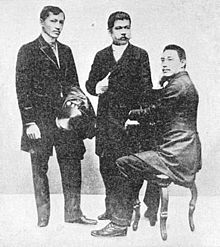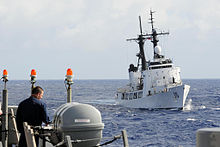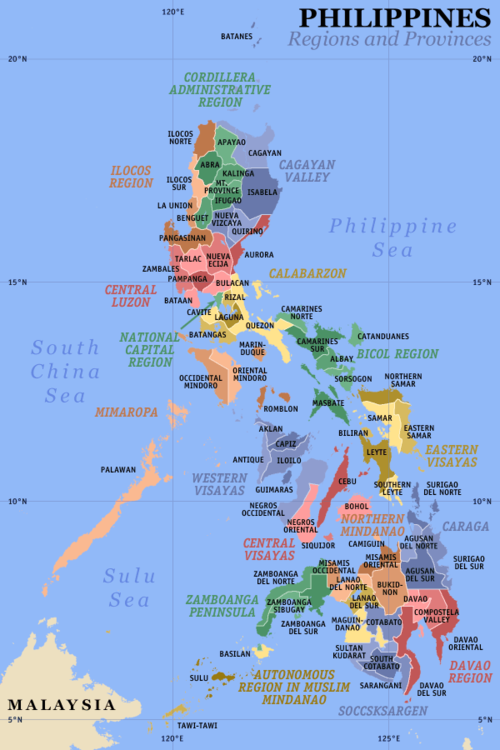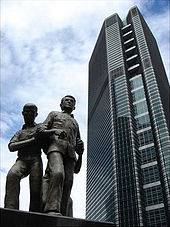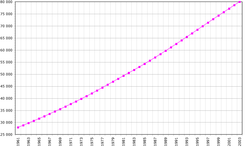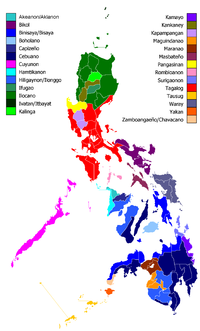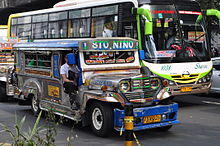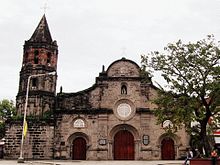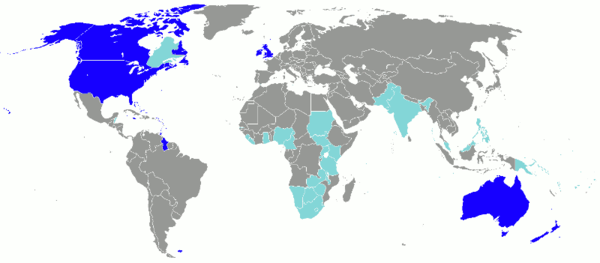- Philippines
-
"Philippine" redirects here. For a town in the Netherlands, see Philippine, Netherlands.
Republic of the Philippines Republika ng Pilipinas

Flag Coat of arms Motto: Maka-Diyos, Maka-Tao, Makakalikasan, at Makabansa[1]
("For God, People, Nature, and Country")Anthem:
Lupang HinirangLocation of Philippines (green)in ASEAN (dark grey) — [Legend]
Capital Manila
14°35′N 121°0′E / 14.583°N 121°ELargest city Quezon City Official language(s) Filipino (based on Tagalog)
EnglishRecognised regional languages Bikol, Cebuano, Hiligaynon, Ilokano, Pampango, Pangasinense, Tagalog, Waray[2] Optional languagesa Spanish and Arabic[3] National language Filipino Demonym Filipino/Filipina Government Unitary presidential constitutional republic - President Benigno Aquino III (LP) - Vice President Jejomar Binay (PDP-Laban) - Senate President Juan Ponce Enrile (PMP) - House Speaker Feliciano Belmonte, Jr. (LP) - Supreme Court Chief Justice Renato Corona Legislature Congress - Upper House Senate - Lower House House of Representatives Independence from Spainb
from United States- Established April 27, 1565 - Declared June 12, 1898 - Self-government March 24, 1934 - Recognized July 4, 1946 - Current constitution February 2, 1987 Area - Land 299,764 km2 [2](72nd)
115,831 sq mi- Water (%) 0.61%[4] (inland waters) Population - 2010 estimate 94,013,200 [5] (12th) - 2007 census 88,574,614[6] - Density 306.6/km2 (43rd)
794.1/sq miGDP (PPP) 2010 estimate - Total $351.370 billion[7] (33rd) - Per capita $3,737[7] GDP (nominal) 2010 estimate - Total $188.719 billion[7] (46th) - Per capita $2,007[7] Gini (2006) 45.8[4] (medium) HDI (2010)  0.638[8] (medium) (97th)
0.638[8] (medium) (97th)Currency Peso (Filipino: piso)
₱ (PHP)Time zone PST (UTC+8) - Summer (DST) not observed (UTC+8) Drives on the right[9] Internet TLD .ph Calling code +63 1 ^a The 1987 Philippine constitution specifies, "Spanish and Arabic shall be promoted on a voluntary and optional basis." 2 ^b Philippine revolutionaries declared independence from Spain on June 12, 1898, but the Spanish claim of sovereignty was passed from Spain to the United States in the Treaty of Paris. This led to the Philippine–American War. 3 ^c Rankings above were taken from associated Wikipedia pages as of October 2010 and may be based on data or data sources other than those appearing here. The Philippines
 i/ˈfɪlɨpiːnz/ (Filipino: Pilipinas [ˌpɪlɪˈpinɐs]), officially known as the Republic of the Philippines (Filipino: Republika ng Pilipinas), is a country in Southeast Asia in the western Pacific Ocean. To its north across the Luzon Strait lies Taiwan. West across the South China Sea sits Vietnam. The Sulu Sea to the southwest lies between the country and the island of Borneo, and to the south the Celebes Sea separates it from other islands of Indonesia. It is bounded on the east by the Philippine Sea. Its location on the Pacific Ring of Fire and its tropical climate make the Philippines prone to earthquakes and typhoons but have also endowed the country with natural resources and made it one of the richest areas of biodiversity in the world. An archipelago comprising 7,107 islands, the Philippines is categorized broadly into three main geographical divisions: Luzon, Visayas, and Mindanao. Its capital city is Manila.
i/ˈfɪlɨpiːnz/ (Filipino: Pilipinas [ˌpɪlɪˈpinɐs]), officially known as the Republic of the Philippines (Filipino: Republika ng Pilipinas), is a country in Southeast Asia in the western Pacific Ocean. To its north across the Luzon Strait lies Taiwan. West across the South China Sea sits Vietnam. The Sulu Sea to the southwest lies between the country and the island of Borneo, and to the south the Celebes Sea separates it from other islands of Indonesia. It is bounded on the east by the Philippine Sea. Its location on the Pacific Ring of Fire and its tropical climate make the Philippines prone to earthquakes and typhoons but have also endowed the country with natural resources and made it one of the richest areas of biodiversity in the world. An archipelago comprising 7,107 islands, the Philippines is categorized broadly into three main geographical divisions: Luzon, Visayas, and Mindanao. Its capital city is Manila.With an estimated population of about 94 million people, the Philippines is the world's 12th most populous country. An additional 11 million Filipinos live overseas. Multiple ethnicities and cultures are found throughout the islands. In prehistoric times, Negritos were some of the archipelago's earliest inhabitants. They were followed by successive waves of Austronesian peoples who brought with them influences from Malay, Hindu, and Islamic societies. Trade introduced Chinese cultural influences which remain to this day.
The arrival of Ferdinand Magellan in 1521 marked the beginning of an era of Spanish interest and eventual dominance. Manila became the Asian hub of the Manila–Acapulco galleon fleet. Christianity was widely adopted. As the 19th century gave way to the 20th, there followed in quick succession the Philippine Revolution which spawned the short-lived First Philippine Republic, the Spanish-American War, and the Philippine–American War. In the aftermath, the United States emerged as the dominant power. Aside from the period of Japanese occupation, the United States retained sovereignty over the islands until the end of World War II when the Philippines gained independence. The United States bequeathed to the Philippines the English language and a stronger affinity for Western culture. Since independence the Philippines has had an often tumultuous experience with democracy, with popular "People Power" movements overthrowing a dictatorship in one instance but also underlining the institutional weaknesses of its constitutional republic in others.
Contents
Etymology
Main article: Name of the PhilippinesThe name Philippines is derived from that of King Philip II of Spain. Spanish explorer Ruy López de Villalobos during his expedition in 1542 named the islands of Leyte and Samar Felipinas after the then Prince of Asturias. Eventually the name Las Islas Filipinas would be used to cover all the islands of the archipelago. Before it became commonplace, other names such as Islas del Poniente (Islands of the West) and Magellan's name for the islands San Lázaro were also used by the Spanish to refer to the islands.[10][11][12][13][14]
The official name of the Philippines has changed several times in the course of the country's history. During the Philippine Revolution, the Malolos Congress proclaimed the establishment of the República Filipina or the Philippine Republic. From the period of the Spanish-American War and the Philippine–American War until the Commonwealth period, American colonial authorities referred to the country as the Philippine Islands, a translation of the Spanish name. During the American period the name Philippines began to appear and it has since become the country's common name.[15] Since independence the official name of the country has been the Republic of the Philippines.
History
Main article: History of the PhilippinesThe metatarsal of Callao Man is reported to have been reliably dated by uranium-series dating to 67,000 years ago[16] thereby replacing the Tabon Man of Palawan, carbon-dated to around 24,000 years ago[17][18] as the oldest human remains found in the archipelago. Negritos were among the archipelago's earliest inhabitants but their appearance in the Philippines has not been reliably dated.[19] There are several opposing theories regarding the origins of ancient Filipinos. F. Landa Jocano theorizes that the ancestors of the Filipinos evolved locally. Wilhelm Solheim's Island Origin Theory[20] postulates that the peopling of the archipelago transpired via trade networks originating in the antediluvian Sundaland area around 48000 to 5000 BCE rather than by wide-scale migration. The Austronesian Expansion Theory states that Malayo-Polynesians coming from Taiwan began migrating to the Philippines around 4000 BCE, displacing earlier arrivals.[21][22] Whatever the case, by 1000 BCE the inhabitants of the archipelago had developed into four kinds of social groups: hunter-gathering tribes, warrior societies, petty plutocracies, and maritime-centered harbor principalities.[23]
Trade between the maritime-oriented peoples and other Asian countries during the subsequent period brought influences from Hinduism, Buddhism, and Islam. During this time there was no unifying political state encompassing the entire Philippine Archipelago. Instead, the islands were divided among competing thalassocracies ruled by various datus, rajahs, or sultans. These thalassocracies were composed of autonomous barangays which were independent to or allied with larger nations. Among them were the kingdoms of Maynila, Namayan, and Tondo, the confederation of Madyaas, the state of Ma-i, the rajahnates of Butuan and Cebu, and the sultanates of Maguindanao and Sulu.[24][25][26][27] Some of these societies were part of the Malayan empires of Srivijaya, Majapahit, and Brunei.[28][29] Islam was brought to the Philippines by traders and proselytizers from Malaysia and Indonesia.[30] By the 15th century, Islam was established in the Sulu Archipelago and by 1565 had reached Mindanao, the Visayas, and Luzon.[31]
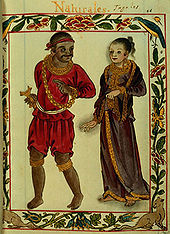 A page from the Boxer Codex. Left, is a general from the Rajahnate of Butuan and to the right is a princess of Tondo.
A page from the Boxer Codex. Left, is a general from the Rajahnate of Butuan and to the right is a princess of Tondo.
In 1521, Portuguese explorer Ferdinand Magellan arrived in the Philippines and claimed the islands for Spain.[32] Colonization began when Spanish explorer Miguel López de Legazpi arrived from Mexico in 1565 and formed the first European settlements in Cebu. In 1571, after dealing with the local royal families in the wake of the Tondo Conspiracy and defeating the Chinese pirate warlord Limahong, the Spanish established Manila as the capital of the Spanish East Indies.[33][34]
Spanish rule contributed significantly to bringing political unity to the archipelago. From 1565 to 1821, the Philippines was governed as a territory of the Viceroyalty of New Spain and then was administered directly from Madrid after the Mexican War of Independence. The Manila galleons linking Manila to Acapulco traveled once or twice a year between the 16th and 19th centuries. Trade introduced foods such as corn, tomatoes, potatoes, chili peppers, and pineapples from the Americas.[34] Roman Catholic missionaries converted most of the lowland inhabitants to Christianity and founded schools, a university, and hospitals. While a Spanish decree introduced free public schooling in 1863, efforts in mass public education mainly came to fruition during the American period.[35]
During its rule, the Spanish fought off various indigenous revolts and several external colonial challenges from Chinese pirates, the Dutch, and the Portuguese. In an extension of the fighting of the Seven Years' War, British forces under the command of Brigadier General William Draper and Rear-Admiral Samuel Cornish briefly occupied Manila. They found local allies like Diego and Gabriela Silang who took the opportunity to lead a revolt, but Spanish rule was eventually restored following the 1763 Treaty of Paris.[30][36][37]
In the 19th century, Philippine ports were opened to world trade and shifts were occurring within Philippine society. Many Spaniards born in the Philippines (criollos) and those of mixed ancestry (mestizos) became wealthy. The influx of Spanish and Latino settlers secularized churches and opened up government positions traditionally held by Spaniards born in the Iberian Peninsula (peninsulares). The ideals of revolution also began to spread through the islands. Criollo dissatisfaction resulted in the revolt in Cavite El Viejo in 1872 that was a precursor to the Philippine Revolution.[30][38][39][40][41]
Revolutionary sentiments were stoked in 1872 after three priests—Mariano Gómez, José Burgos, and Jacinto Zamora (collectively known as Gomburza)—were accused of sedition by colonial authorities and executed.[38][39] This would inspire a propaganda movement in Spain, organized by Marcelo H. del Pilar, José Rizal, and Mariano Ponce, lobbying for political reforms in the Philippines. Rizal was eventually executed on December 30, 1896, on charges of rebellion.[42] As attempts at reform were meeting with resistance, Andrés Bonifacio in 1892 established the secret society called the Katipunan, a society along the lines of the freemasons, which sought independence from Spain through armed revolt.[40] Bonifacio and the Katipunan started the Philippine Revolution in 1896. A faction of the Katipunan, the Magdalo of Cavite province, eventually came to challenge Bonifacio's position as the leader of the revolution and Emilio Aguinaldo took over. In 1898, the Spanish-American War began in Cuba and reached the Philippines. Aguinaldo declared Philippine independence from Spain in Kawit, Cavite on June 12, 1898 and the First Philippine Republic was established the following year. Meanwhile, the islands were ceded by Spain to the United States for US$20 million in the 1898 Treaty of Paris.[43] As it became increasingly clear the United States would not recognize the First Philippine Republic, the Philippine–American War broke out. It ended with American control over the islands which were then administered as an insular area.[44]
In 1935, the Philippines was granted Commonwealth status. Plans for independence over the next decade were interrupted by World War II when the Japanese Empire invaded and established a puppet government. Many atrocities and war crimes were committed during the war such as the Bataan Death March and the Manila massacre that culminated during the Battle of Manila.[45] Allied troops defeated the Japanese in 1945. By the end of the war it is estimated over a million Filipinos had died.[46] On July 4, 1946, the Philippines attained its independence.[4] Immediately after World War II, the Philippines faced a number of challenges. The country had to be rebuilt from the ravages of war. It also had to come to terms with Japanese collaborators. Meanwhile, disgruntled remnants of the Hukbalahap communist rebel army that had previously fought against and resisted the Japanese continued to roam the rural regions. Eventually this threat was dealt with by Secretary of National Defense and later President Ramon Magsaysay but sporadic cases of communist insurgency continued to flare up long afterward.[47][48] In 1965, Ferdinand Marcos was elected president, his wife Imelda Marcos at his side. Nearing the end of his second term and constitutionally barred from seeking a third, he declared martial law on September 21, 1972. By using political divisions, the tension of the Cold War, and the specter of communist rebellion and Islamic insurgency as justifications, he was able to govern by decree.[49]
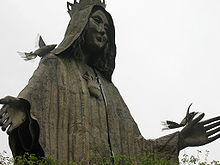 A statue of the Virgin Mary built at the EDSA Shrine after the People Power Revolution
A statue of the Virgin Mary built at the EDSA Shrine after the People Power Revolution
On August 21, 1983, Marcos' chief rival opposition leader Benigno "Ninoy" Aquino, Jr. ignored warnings and returned from exile in the United States. He was assassinated as he was taken off the plane at the Manila International Airport (now called the Ninoy Aquino International Airport in his memory). With political pressure building, Marcos eventually called for snap presidential elections in 1986.[47] Corazon Aquino, Benigno's widow, was persuaded to become the presidential candidate and standard bearer of the opposition. The elections were widely thought of as rigged when Marcos was proclaimed the winner. This led to the People Power Revolution, instigated when two long-time Marcos allies—Armed Forces of the Philippines Vice Chief-of-Staff Fidel V. Ramos and Secretary of National Defense Juan Ponce Enrile—resigned and barricaded themselves in Camp Aguinaldo and Camp Crame. Exhorted by the Cardinal Archbishop of Manila Jaime Sin, people gathered in support of the rebel leaders and protested on Epifanio de los Santos Avenue (EDSA). In the face of mass protests and military defections, Marcos and his allies fled to Hawaii and into exile. Corazon Aquino was recognized as president.[48][50]
The return of democracy and government reforms after the events of 1986 were hampered by national debt, government corruption, coup attempts, a persistent communist insurgency, and Islamic separatists. The economy improved during the administration of Fidel V. Ramos, who was elected president in 1992.[51] However, the economic improvements were negated with the onset of the East Asian financial crisis in 1997. In 2001, amid charges of corruption and a stalled impeachment process, Ramos' successor Joseph Estrada was ousted from the presidency by the 2001 EDSA Revolution and replaced by Gloria Macapagal-Arroyo. As a result of the May 2010 elections, Benigno "Noynoy" Aquino III was elected president.
Politics and government
Main articles: Politics of the Philippines, President of the Philippines, and Constitution of the PhilippinesThe Philippines is a constitutional republic with a presidential system of government. It is governed as a unitary state with the exception of the Autonomous Region in Muslim Mindanao which is largely free from the national government. The President functions as both head of state and head of government and is the commander-in-chief of the armed forces. The president is elected by popular vote for a single six-year term, during which he or she appoints and presides over the cabinet.[2]
The bicameral Congress is composed of the Senate, serving as the upper house, with members elected to a six-year term, and the House of Representatives, serving as the lower house, with members elected to a three-year term. The senators are elected at large while the representatives are elected from both legislative districts and through sectoral representation.[2]
The judicial power is vested in the Supreme Court, composed of a Chief Justice as its presiding officer and fourteen associate justices, all of whom are appointed by the President from nominations submitted by the Judicial and Bar Council.[2]
There have been attempts to change the government to a federal, unicameral, or parliamentary government since the Ramos administration.[52][53]
Security and defense
Main articles: Armed Forces of the Philippines and Philippine National PolicePhilippine defense is handled by the Armed Forces of the Philippines and is composed of three branches: the Air Force, the Army, and the Navy (including the Marine Corps). Civilian security is handled by Philippine National Police under the Department of the Interior and Local Government (DILG).
In the Autonomous Region in Muslim Mindanao, the largest separatist organization, the Moro National Liberation Front, is now engaging the government politically. Other more militant groups like the Moro Islamic Liberation Front, the communist New People's Army, and the Abu Sayyaf still roam the provinces, but their presence has decreased in recent years due to successful security provided by the Philippine government.[54][55]
The Philippines has been an ally of the United States since World War II. A mutual defense treaty between the two countries was signed in 1951. The Philippines supported American policies during the Cold War and participated in the Korean and Vietnam wars. It was a member of the now dissolved SEATO, a group that was intended to serve a role similar to NATO and that included Australia, France, New Zealand, Pakistan, Thailand, the United Kingdom, and the United States.[56] After the start of the War on Terror, the Philippines was part of the coalition that gave support to the United States in Iraq.[57] The United States designated the country a major non-NATO ally. The Philippines is currently working to end its domestic insurgency with help from the United States.
International relations
Main article: Foreign relations of the PhilippinesThe Philippines' international relations are based on trade with other nations and the well-being of the 11 million overseas Filipinos living outside the country.[58] As a founding and active member of the United Nations, the Philippines has been elected several times into the Security Council. Carlos P. Romulo was a former President of the United Nations General Assembly. The country is an active participant in the Human Rights Council as well as in peacekeeping missions, particularly in East Timor.[59][60][61][62]
In addition to membership in the United Nations, the country is also a founding and active member of ASEAN (Association of Southeast Asian Nations), an organization designed to strengthen relations and promote economic and cultural growth among states in the Southeast Asian region.[63] It has hosted several summits and is an active contributor to the direction and policies of the bloc.[64] The relations it currently enjoys with other Southeast Asian states are in contrast to its relations with them before the 1970s when it was at war with Vietnam and was heavily disputing Sabah with Malaysia; although, disagreements continue to exist due to the Spratly Islands.[65]
The Philippines values its relations with the United States.[58] It supported the United States during the Cold War and the War on Terror and is a major non-NATO ally. Despite this history of goodwill, controversies related to the presence of the now former U.S. military bases in Subic Bay and Clark and the current Visiting Forces Agreement have flared up from time to time.[58] Japan, the biggest contributor of official development assistance to the country,[66] is thought of as a friend. Although historical tensions still exist on issues such as the plight of comfort women much of the animosity inspired by memories of World War II have faded.[67]
Relations with other nations are generally positive. Shared democratic values ease relations with Western and European countries while similar economic concerns help in relations with other developing countries. Historical ties and cultural similarities also serve as a bridge in relations with Spain and Latin America. Despite issues such as domestic abuse and war affecting overseas Filipino workers and obstacles posed by Islamic insurgency in Mindanao, relations with Middle Eastern countries (including Egypt, Iran, Iraq, Libya, Saudi Arabia, and the United Arab Emirates) are friendly as seen in the continuous employment of more than two million overseas Filipinos living there.
With communism no longer the threat it once was, once hostile relations in the 1950s between the Philippines and the People's Republic of China have improved greatly. Issues involving Taiwan, the Spratly Islands, and concerns of expanding Chinese influence, however, still encourage a degree of carefulness.[67] Recent foreign policy has been mostly about economic relations with its Southeast Asian and Asia-Pacific neighbors.[58]
The Philippines is a member of the East Asia Summit (EAS), the Asia-Pacific Economic Cooperation (APEC), the Latin Union, the Group of 24, and the Non-Aligned Movement.[2] It is also seeking to strengthen relations with Islamic countries by campaigning for observer status in the Organisation of Islamic Cooperation.[68][69]
Administrative divisions
Main article: Administrative divisions of the PhilippinesThe Philippines is divided into three island groups: Luzon, Visayas, and Mindanao. As of March 2010[update], these were divided into 17 regions, 80 provinces, 138 cities, 1,496 municipalities, and 42,025 barangays.[70] In addition, Section 2 of Republic Act No. 5446 asserts that the definition of the territorial sea around the Philippine archipelago does not affect the claim over Sabah.[71]
A clickable map of the Philippines exhibiting its 17 regions and 80 provinces.Region Designation Regional center Ilocos Region Region I San Fernando, La Union Cagayan Valley Region II Tuguegarao, Cagayan Central Luzon Region III San Fernando, Pampanga CALABARZON Region IV-A Calamba, Laguna MIMAROPA Region IV-B Calapan, Oriental Mindoro Bicol Region Region V Legazpi, Albay Western Visayas Region VI Iloilo City Central Visayas Region VII Cebu City Eastern Visayas Region VIII Tacloban Zamboanga Peninsula Region IX Zamboanga City Northern Mindanao Region X Cagayan de Oro Davao Region Region XI Davao City SOCCSKSARGEN Region XII Koronadal, South Cotabato Caraga Region XIII Butuan Autonomous Region in Muslim Mindanao ARMM Cotabato City Cordillera Administrative Region CAR Baguio National Capital Region NCR Manila Geography
Main article: Geography of the PhilippinesThe Philippines is an archipelago of 7,107 islands[2] with a total land area, including inland bodies of water, of approximately 300,000 square kilometers (120,000 sq mi). Its 36,289 kilometers (22,549 mi) of coastline makes it the country with the 5th longest coastline in the world.[2][72] It is located between 116° 40', and 126° 34' E. longitude and 4° 40' and 21° 10' N. latitude and is bordered by the Philippine Sea to the east, the South China Sea to the west, and the Celebes Sea to the south. The island of Borneo is located a few hundred kilometers southwest and Taiwan is located directly to the north. The Moluccas and Sulawesi are located to the south-southwest and Palau is located to the east of the islands.[2]
Most of the mountainous islands are covered in tropical rainforest and volcanic in origin. The highest mountain is Mount Apo. It measures up to 2,954 meters (9,692 feet) above sea level and is located on the island of Mindanao. The Galathea Depth in the Philippine Trench is the deepest point in the country and the third deepest in the world. The trench is located in the Philippine Sea. The longest river is the Cagayan River in northern Luzon. Manila Bay, upon the shore of which the capital city of Manila lies, is connected to Laguna de Bay, the largest lake in the Philippines, by the Pasig River. Subic Bay, the Davao Gulf, and the Moro Gulf are other important bays. The San Juanico Strait separates the islands of Samar and Leyte but it is traversed by the San Juanico Bridge.[73]

Ancient Filipinos utilized terrace farming to grow crops in the steep mountainous regions of northern Philippines. Situated on the western fringes of the Pacific Ring of Fire, the Philippines experiences frequent seismic and volcanic activity. The Benham Plateau to the east in the Philippine Sea is an undersea region active in tectonic subduction.[74] Around 20 earthquakes are registered daily, though most are too weak to be felt. The last major earthquake was the 1990 Luzon earthquake.[75] There are many active volcanoes such as the Mayon Volcano, Mount Pinatubo, and Taal Volcano. The eruption of Mount Pinatubo in June 1991 produced the second largest terrestrial eruption of the 20th century.[76] Not all notable geographic features are so violent or destructive. A more serene legacy of the geological disturbances is the Puerto Princesa Subterranean River. The white sand beaches that make Boracay a popular vacation getaway are made of coral remnants.
Due to the volcanic nature of the islands, mineral deposits are abundant. The country is estimated to have the second-largest gold deposits after South Africa and one of the largest copper deposits in the world.[77] It is also rich in nickel, chromite, and zinc. Despite this, poor management, high population density, and environmental consciousness have resulted in these mineral resources remaining largely untapped.[77] Geothermal energy, however, is another product of volcanic activity that the country has harnessed more successfully. The Philippines is the world's second-biggest geothermal producer behind the United States, with 18% of the country's electricity needs being met by geothermal power.[78]
Flora and fauna
Main article: Wildlife of the PhilippinesThe Philippines' rainforests and its extensive coastlines make it home to a diverse range of birds, plants, animals, and sea creatures.[79] It is one of the ten most biologically mega-diverse countries and is at or near the top in terms of biodiversity per unit area.[80][81][82] Around 1,100 land vertebrate species can be found in the Philippines including over 100 mammal species and 170 bird species not thought to exist elsewhere.[83] Endemic species include the tamaraw of Mindoro, the Visayan spotted deer, the Philippine mouse deer, the Visayan warty pig, the Philippine flying lemur, and several species of bats.[84]
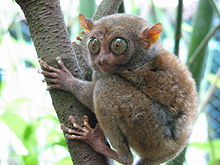 Philippine tarsier (Tarsius syrichta), one of the smallest primates.
Philippine tarsier (Tarsius syrichta), one of the smallest primates.
The Philippines lacks large predators, with the exception of snakes, such as pythons and cobras, and birds of prey, such as the national bird, known as the Philippine eagle.[85] Other native animals include the palm civet cat, the dugong, and the Philippine tarsier associated with Bohol. With an estimated 13,500 plant species in the country, 3,200 of which are unique to the islands,[83] Philippine rainforests boast an array of flora, including many rare types of orchids and rafflesia.[86][87] The narra is considered as the most important type of hardwood.[88]
Philippine maritime waters encompass as much as 2.2 million square kilometers (850,000 square miles) producing unique and diverse marine life and is an important part of the Coral Triangle.[71] There are 2,400 fish species and over 500 species of coral.[79][83] The Apo Reef is the country's largest contiguous coral reef system and the second-largest in the world.[89] Philippine waters also sustain the cultivation of pearls, crabs, and seaweeds.[79][90]
Deforestation, often the result of illegal logging, is an acute problem in the Philippines. Forest cover declined from 70% of the country's total land area in 1900 to about 18.3% in 1999.[91][92] Many species are endangered and scientists say that Southeast Asia, which the Philippines is part of, faces a catastrophic extinction rate of 20% by the end of the century.[93] According to Conservation International, "the country is one of the few nations that is, in its entirety, both a hotspot and a megadiversity country, placing it among the top priority hotspots for global conservation."[86]
Climate
 Typhoon Megi (Juan) over the Philippines.
Typhoon Megi (Juan) over the Philippines. Main article: Climate of the Philippines
Main article: Climate of the PhilippinesThe Philippines has a tropical maritime climate and is usually hot and humid. There are three seasons: tag-init or tag-araw, the hot dry season or summer from March to May; tag-ulan, the rainy season from June to November; and tag-lamig, the cool dry season from December to February. The southwest monsoon (from May to October) is known as the Habagat, and the dry winds of the northeast monsoon (from November to April), the Amihan.[94] Temperatures usually range from 21°C (70°F) to 32°C (90°F) although it can get cooler or hotter depending on the season. The coolest month is January; the warmest is May.[2][95]
The average yearly temperature is around 26.6°C (79.88°F).[94] In considering temperature, location in terms of latitude and longitude is not a significant factor. Whether in the extreme north, south, east, or west of the country, temperatures at sea level tend to be in the same range. Altitude usually has more of an impact. The average annual temperature of Baguio at an elevation of 1,500 meters (4,900 feet) above sea level is 18.3°C (64.9°F), making it a popular destination during hot summers.[94] Likewise, Tagaytay is a favored retreat.
Sitting astride the typhoon belt, most of the islands experience annual torrential rains and thunderstorms from July to October,[96] with around nineteen typhoons entering the Philippine area of responsibility in a typical year and eight or nine making landfall.[97][98][99] Annual rainfall measures as much as 5,000 millimeters (200 inches) in the mountainous east coast section but less than 1,000 millimeters (39 inches) in some of the sheltered valleys.[96] The wettest known tropical cyclone to impact the archipelago was the July 1911 cyclone, which dropped over 1,168 millimetres (46.0 in) of rainfall within a 24-hour period in Baguio City.[100] Bagyo is the local term for a tropical cyclone in the Philippines.[100]
Economy
Main article: Economy of the PhilippinesThe national economy of the Philippines is the 46th largest in the world, with an estimated 2010 gross domestic product (nominal) of $189 billion.[7] Primary exports include semiconductors and electronic products, transport equipment, garments, copper products, petroleum products, coconut oil, and fruits.[4] Major trading partners include the United States, Japan, China, Singapore, South Korea, the Netherlands, Hong Kong, Germany, Taiwan, and Thailand.[4] Its unit of currency is the Philippine peso (₱ or PHP).

Makati, the country's financial center. A newly industrialized country, the Philippine economy has been transitioning from one based on agriculture to one based more on services and manufacturing. Of the country's total labor force of around 38.1 million,[4] the agricultural sector employs close to 32% but contributes to only about 13.8% of GDP. The industrial sector employs around 13.7% of the workforce and accounts for 30% of GDP. Meanwhile the 46.5% of workers involved in the services sector are responsible for 56.2% of GDP.[101][102]
The unemployment rate as of July 2009 stands at around 7.6% and due to the global economic slowdown inflation as of September 2009 reads 0.70%.[102] Gross international reserves as of July 2011 are $75.174 billion.[103] In 2004, public debt as a percentage of GDP was estimated to be 74.2%; in 2008, 56.9%.[4] Gross external debt has risen to $66.27 billion.[4] The country is a net importer.[102]
After World War II, the country was for a time regarded as the second wealthiest in East Asia, next only to Japan.[58][104][105] However, by the 1960s its economic performance started being overtaken. The economy stagnated under the dictatorship of Ferdinand Marcos as the regime spawned economic mismanagement and political volatility.[58][105] The country suffered from slow economic growth and bouts of economic recession. Only in the 1990s with a program of economic liberalization did the economy begin to recover.[58][105]
The 1997 Asian Financial Crisis affected the economy, resulting in a lingering decline of the value of the peso and falls in the stock market. But the extent it was affected initially was not as severe as that of some of its Asian neighbors. This was largely due to the fiscal conservatism of the government, partly as a result of decades of monitoring and fiscal supervision from the International Monetary Fund (IMF), in comparison to the massive spending of its neighbors on the rapid acceleration of economic growth.[51] There have been signs of progress since. In 2004, the economy experienced 6.4% GDP growth and 7.1% in 2007, its fastest pace of growth in three decades.[7][106][107] Yet average annual GDP growth per capita for the period 1966–2007 still stands at 1.45% in comparison to an average of 5.96% for the East Asia and the Pacific region as a whole and the daily income for 45% of the population of the Philippines remains less than $2.[108][109] Despite enjoying sustained economic growth during the first decade of the 21st century, as of 2010[update], the country's economy remains smaller than those of its Southeast Asian neighbors Indonesia, Thailand, Malaysia, and Singapore in terms of GDP and GDP per capita (nominal).[110]
Other incongruities and challenges exist. The economy is heavily reliant on remittances which surpass foreign direct investment as a source of foreign currency. Regional development is uneven with Luzon—Metro Manila in particular—gaining most of the new economic growth at the expense of the other regions,[111] although the government has taken steps to distribute economic growth by promoting investment in other areas of the country. Despite constraints, service industries such as tourism and business process outsourcing have been identified as areas with some of the best opportunities for growth for the country.[102][112] Goldman Sachs includes the country in its list of the "Next Eleven" economies.[113] But China and India have emerged as major economic competitors.[114]
The Philippines is a member of the World Bank, the International Monetary Fund, the World Trade Organization (WTO), the Asian Development Bank which is headquartered in Mandaluyong City, the Colombo Plan, and the G-77 among other groups and institutions.[4]
Demographics
Population in Philippines[115] Year Million 1971 37.6 1980 48.1 1990 62.4 2000 77.7 2004 83.9 2008 90.3 Source: OECD/World Bank Population in Philippines increased from 1990 to 2008 with 28 million with 45 % growth.[115] The first official census in the Philippines was carried out in 1877 and recorded a population of 5,567,685.[116] As of 2011, the Philippines has become the world's 12th most populous nation, with a population of over 94 million. It is estimated that half of the population resides on the island of Luzon. The population growth rate between 1995 to 2000 of 3.21% decreased to an estimated 1.95% for the 2005 to 2010 period, but remains a contentious issue.[6][117] The population's median age is 22.7 years with 60.9% aged from 15 to 64 years old.[4] Life expectancy at birth is 71.38 years, 74.45 years for females and 68.45 years for males.[118]
There are about 11 million Filipinos outside the Philippines.[119] Since the liberalization of United States immigration laws in 1965, the number of people in the United States having Filipino ancestry has grown substantially. In 2007 there were an estimated 3.1 million.[120][121] According to the United States Census Bureau, immigrants from the Philippines made up the second largest group after Mexico that sought family reunification.[122] Some two million Filipinos work in the Middle East, with nearly a million in Saudi Arabia alone.[123]
Ethnicity
Main article: Ethnic groups of the PhilippinesAccording to the 2000 census 28.1% of Filipinos are Tagalog, 13.1% Cebuano, 9% Ilocano, 7.6% Bisaya/Binisaya, 7.5% Hiligaynon, 6% Bikol, 3.4% Waray, and 25.3% are classified as other.[4][124] These general headings can be broken down further to yield more distinct non-tribal groups like the Moro, the Kapampangan, the Pangasinense, the Ibanag, and the Ivatan.[125] There are also indigenous peoples like the Igorot, the Lumad, the Mangyan, the Bajau, and the tribes of Palawan.[126] Negritos, such as the Aeta and the Ati, are considered among the earliest inhabitants of the islands.[127]
Filipinos generally belong to several Asian ethnic groups classified linguistically as part of the Austronesian or Malayo-Polynesian speaking people.[126] It's believed that thousands of years ago Taiwanese aborigines migrated to the Philippines from Taiwan, bringing with them knowledge of agriculture and ocean-sailing, and displacing the earlier Negrito groups of the islands.[128]
Eventually Chinese, Spanish, and American arrivals intermarried with the various indigenous ethnic groups that had evolved.[128] Their descendants are known as mestizos.[129] Chinese Filipinos number about two million.[130] Other migrant ethnic groups who have settled in the country from elsewhere include Arabs, Britons, other Europeans, Indonesians, Japanese, Koreans, and South Asians.
Cities
Main article: Cities of the PhilippinesMetro Manila is the most populous of the twelve defined metropolitan areas in the Philippines and the 11th most populous in the world. As of the 2007 census, it had a population of 11,553,427, comprising 13% of the national population.[131] Including suburbs in the adjacent provinces (Bulacan, Cavite, Laguna, and Rizal) of Greater Manila, the population is around 21 million.[131][132]
Metro Manila's gross regional product is estimated as of July 2009 to be ₱468.4 billion (at constant 1985 prices) and accounts for 33% of the nation's GDP.[133] In 2008, it ranked as the 40th wealthiest urban agglomeration in the world and the 2nd in Southeast Asia, according to PricewaterhouseCoopers.[134] Davao City in Mindanao and Cebu City in the Visayas are other important urban centers.
Largest cities of Philippines
Philippines 2007 CensusRank City Name Region Pop. Rank City Name Region Pop. 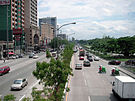
Quezon City
1 Quezon City Metro Manila 2,679,450 11 Dasmariñas CALABARZON 556,330 
Caloocan
2 Manila Metro Manila 1,660,714 12 Cagayan de Oro Northern Mindanao 553,966 3 Caloocan Metro Manila 1,378,856 13 Parañaque Metro Manila 552,660 4 Davao City Davao Region 1,363,337 14 Las Piñas Metro Manila 532,223 5 Cebu City Central Visayas 798,809 15 General Santos SOCCSKSARGEN 529,542 6 Zamboanga City Zamboanga Peninsula 774,407 16 Makati Metro Manila 510,383 7 Antipolo CALABARZON 633,971 17 Bacolod Western Visayas 499,497 8 Pasig Metro Manila 617,301 18 Muntinlupa Metro Manila 452,943 9 Taguig Metro Manila 613,343 19 Tagum Davao Region 450,526 10 Valenzuela Metro Manila 568,928 20 San Jose del Monte Central Luzon 439,090 Language
Main article: Languages of the PhilippinesNative Languages (2000)[135] Tagalog 22 million Cebuano 20 million Ilokano 7.7 million Hiligaynon 7 million Waray-Waray 3.1 million Ethnologue lists 175 individual languages in the Philippines, 171 of which are living languages while 4 no longer have any known speakers. They are part of the Borneo–Philippines group of the Malayo-Polynesian languages, which is itself a branch of the Austronesian language family.[126]
According to the 1987 Philippine Constitution, Filipino and English are the official languages. Filipino is a de facto version of Tagalog, spoken mainly in Metro Manila and other urban regions. Both Filipino and English are used in government, education, print, broadcast media, and business. The constitution designates regional languages such as Bicolano, Cebuano, Ilocano, Hiligaynon, Kapampangan, Pangasinan, Tagalog, and Waray-Waray as auxiliary official languages, and mandates that Spanish and Arabic shall be promoted on a voluntary and optional basis.[3]
Other languages such as Aklanon, Boholano, Chavacano, Zamboangueño, Cuyonon, Ifugao, Itbayat, Ivatan, Kalinga, Kamayo, Kankana-ey, Kinaray-a, Maguindanao, Maranao, Masbatenyo, Romblomanon, Surigaonon, Tausug, Yakan, and several Visayan languages are prevalent in their respective provinces.
Religion
Main article: Religion in the PhilippinesMore than 90% of the population are Christians: about 80% belong to the Roman Catholic Church while 10% belong to other Christian denominations, such as the Iglesia ni Cristo, the Philippine Independent Church, the Seventh-day Adventist Church, United Church of Christ in the Philippines, and Jehovah's Witnesses.[136] The Philippines is one of two predominantly Roman Catholic countries in Asia, the other being East Timor.
Between five and ten percent of the population are Muslim, most of whom live in parts of Mindanao, Palawan, and the Sulu Archipelago—an area known as Bangsamoro or the Moro region.[137][138] Some have migrated into urban and rural areas in different parts of the country. Most Muslim Filipinos practice Sunni Islam according to the Shafi'i school.[31] Philippine traditional religions are still practiced by many aboriginal and tribal groups, often syncretized with Christianity and Islam. Animism, folk religion, and shamanism remain present as undercurrents of mainstream religion, through the albularyo, the babaylan, and the manghihilot. Buddhism, Taoism, and Chinese folk religion, are dominant in Chinese communities.[138] There are also followers of Judaism and Baha'i.[139]
Education
Main article: Education in the PhilippinesThe National Statistics Office reports a simple literacy rate of 93.4% and a functional literacy rate of 84.1% for 2003.[4][102][108] Literacy is about equal for males and females.[4] Spending for education is around 2.5% of GDP.[4] According to the Department of Education, or DepEd, there were 44,846 elementary schools and 10,384 secondary schools registered for the school year 2009–2010[140] while the Commission on Higher Education (CHED) lists 2,180 higher education institutions, 607 of which are public and 1,573 private.[141] Classes start in June and end in March. The majority of colleges and universities follow a semester calendar from June to October and November to March. There are a number of foreign schools with study programs.[2] Republic Act No. 9155 gives the framework of basic education in the Philippines and provides for compulsory elementary education and free high school education.[142]
Several government agencies are involved with education. The Department of Education covers elementary, secondary, and nonformal education; the Technical Education and Skills Development Authority (TESDA) administers the post-secondary middle-level education training and development; and the Commission on Higher Education (CHED) supervises the college and graduate academic programs and degrees as well as regulates standards in higher education.[143] In 2004, madrasahs were mainstreamed in 16 regions nationwide mainly in Muslim areas in Mindanao under the auspices and program of the Department of Education.[144] Public universities are all non-sectarian entities, and are further classified as State University and College (SUC) or Local College and University (LCU).[141] SUCs are funded by the national government as determined by the Philippine Congress.[145] The University of the Philippines is the national university of the Philippines.[146]
Health
Main articles: Health in the Philippines and List of hospitals in the PhilippinesMost of the national burden of health care is taken up by private health providers. In 2006, total expenditures on health represented 3.8% of GDP. 67.1% of that came from private expenditures while 32.9% was from government. External resources accounted for 2.9% of the total. Health expenditures represented about 6.1% of total government spending. Per capita total expenditure at average exchange rate was $52.[147] The proposed national health budget for 2010 is ₱28 billion (about $597 million) or ₱310 ($7) per person.[148] The government share of total spending on health has declined steadily, and with more people, there has been less to spend per person.
There are an estimated 90,370 physicians or 1 per every 833 people, 480,910 nurses, 43,220 dentists, and 1 hospital bed per every 769 people.[147] Retention of skilled practitioners is a problem. 70% of nursing graduates go overseas to work. The country is the biggest supplier of nurses.[149] In 2001 there were about 1,700 hospitals, of which about 40% were government-run and 60% private. Cardiovascular diseases account for more than 25% of all deaths. According to official estimates, 1,965 cases of human immunodeficiency virus (HIV) were reported in 2003, of which 636 had developed acquired immune deficiency syndrome (AIDS). Other estimates have as many as 12,000 people living with HIV/AIDS in 2005.[150]
Infrastructure
Transportation
Main article: Transportation in the PhilippinesA jeepney and a bus, common forms of public transport in the Philippines
The transportation infrastructure in the country is relatively underdeveloped. Partly this is due to the mountainous terrain and the scattered geography of the islands, but it is also the result of the government's persistent underinvestment in infrastructure. In 2003, only 3.6% of GDP went to infrastructure development which was significantly lower than that of some of its neighbors.[96] Consequently, while there are 203,025 kilometers (126,154 mi) of roads in the country, only around 20% of the total is paved.[151]
Nevertheless there are many ways to get around, especially in urban areas. Buses, jeepneys, taxis, and motorized tricycles are commonly available in major cities and towns. In 2007, there were about 5.53 million registered motor vehicles with registration increasing at an average annual rate of 4.55%.[152] Train services are provided by three main railway networks that serve different areas of Metro Manila and parts of Luzon: the Manila Light Rail Transit System (LRT), the Manila Metro Rail Transit System (MRT), and the Philippine National Railways (PNR).
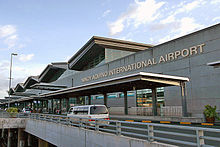 Terminal 3 of Ninoy Aquino International Airport, the main gateway to the country
Terminal 3 of Ninoy Aquino International Airport, the main gateway to the country
As an archipelago, inter-island travel via watercraft is often necessary. The busiest seaports are Manila, Cebu, Iloilo, Davao, Cagayan de Oro, and Zamboanga.[153] Passenger ships and other sea vessels such as those operated by Superferry, Negros Navigation, and Sulpicio Lines serve Manila, with links to various cities and towns. In 2003, the 919-kilometer (571 mi) Strong Republic Nautical Highway (SRNH), an integrated set of highway segments and ferry routes covering 17 cities was established.[154]
Some rivers that pass through metropolitan areas, such as the Pasig River and Marikina River, have air-conditioned commuter ferries. The Pasig River Ferry Service has numerous stops in Manila, Makati, Mandaluyong, Pasig and Marikina.[155] There are 3,219 kilometers (2,000 mi) of navigable inland waterways.[4]
There are 85 public airports in the country, and around 111 more that are private.[151] The Ninoy Aquino International Airport (NAIA) is the main international airport. Other important airports include the Diosdado Macapagal International Airport, Mactan-Cebu International Airport, Francisco Bangoy International Airport and Zamboanga International Airport. Philippine Airlines, Asia's oldest commercial airline still operating under its original name, and Cebu Pacific, the leading low-cost airline, are the major airlines serving most domestic and international destinations.[156][157][158]
Communications
Main articles: Communications in the Philippines, Internet in the Philippines, and Social networking in the PhilippinesThe Philippines has a sophisticated cellular phone industry and a high concentration of users.[159] As of 2008, there are about 67.9 million cellular phone subscribers in the Philippines.[160] Text messaging is a popular form of communication and has fostered a culture of quick greetings and forwarded jokes among Filipinos. In 2007, the nation sent an average of one billion SMS messages per day.[161] Out of this growing number of avid text message senders, over five million of them use their cellular phones as virtual wallets, making it a leader among developing nations in providing financial transactions over cellular networks.[162]
The Philippine Long Distance Telephone Company commonly known as PLDT is the leading telecommunications provider. It is also the largest company in the country.[159][163] Its wholly owned subsidiaries Smart Communications and Piltel, along with Globe Telecom of the Ayala Group, BayanTel, and Sun Cellular are the major cellular service providers in the country.
There are approximately 383 AM and 659 FM radio stations and 297 television and 873 cable television stations.[164] Estimates for internet penetration in the Philippines vary widely ranging from a low of 2.5 million to a high of 24 million people.[165][166] Social networking and watching videos are among the most frequent internet activities.[167][168]
Culture and society
Main articles: Culture of the Philippines, Literature of the Philippines, Music of the Philippines, and Original Pilipino Music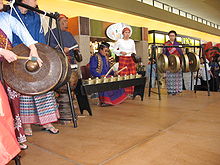 Percussion instruments that make up the Philippine kulintang ensemble, an example of pre-Hispanic musical tradition
Percussion instruments that make up the Philippine kulintang ensemble, an example of pre-Hispanic musical tradition
Philippine culture is a combination of Eastern and Western cultures. The Philippines exhibits aspects found in other Asian countries with a Malay[169] heritage, yet its culture also displays a significant amount of Spanish and American influences. Traditional festivities known as barrio fiestas (district festivals) to commemorate the feast days of patron saints are common. The Moriones Festival and Sinulog Festival are a couple of the most well-known. These community celebrations are times for feasting, music, and dancing. Some traditions, however, are changing or gradually being forgotten due to modernization. The Bayanihan Philippine National Folk Dance Company has been lauded for preserving many of the various traditional folk dances found throughout the Philippines. They are famed for their iconic performances of Philippine dances such as the tinikling and singkil that both feature the use of clashing bamboo poles.[170]
One of the most visible Hispanic legacies is the prevalence of Spanish names and surnames among Filipinos. However, a Spanish name and surname does not necessarily denote Spanish ancestry. This peculiarity, unique among the people of Asia, came as a result of a colonial decree, the Clavería edict, for the systematic distribution of family names and implementation of the Spanish naming system on the population.[171] The names of many streets, towns, and provinces are also in Spanish. Spanish architecture has left an imprint in the Philippines in the way many towns were designed around a central square or plaza mayor, but many of the buildings bearing its influence were demolished during World War II.[24] Some examples remain, mainly among the country's churches, government buildings, and universities. Four Philippine baroque churches are included in the list of UNESCO World Heritage Sites: the San Agustín Church in Manila, the Paoay Church in Ilocos Norte, the Nuestra Señora de la Asunción (Santa María) Church in Ilocos Sur, and the Santo Tomás de Villanueva Church in Iloilo.[172] Vigan in Ilocos Sur is also known for the many Hispanic-styled houses and buildings preserved there.[173]
The common use of the English language is an example of the American impact on Philippine society. It has contributed to the ready acceptance and influence of American pop cultural trends. This affinity is seen in Filipinos' love of fast food, film, and music. Fast food outlets are found on many street corners. American global fast food chain stalwarts have entered the market, but local fast food chains like Goldilocks and most notably Jollibee, the leading fast food chain in the country, have emerged and compete successfully against their foreign rivals.[174][175] Filipinos regularly listen to and watch contemporary American, Asian, and European music and film just as they enjoy Original Pilipino Music (also known as OPM) and local films.
Cuisine
Main article: Philippine cuisine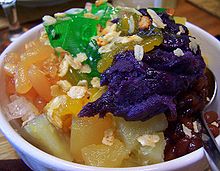 The halo-halo is a dessert made of ice, milk, various fruits, and ice cream.
The halo-halo is a dessert made of ice, milk, various fruits, and ice cream.
Philippine cuisine has evolved over several centuries from its Malayo-Polynesian origins to become a mixed cuisine with many Hispanic, Chinese, American, and other Asian influences that have been adapted to local ingredients and the Filipino palate to create distinctively Filipino dishes. Dishes range from the very simple, like a meal of fried salted fish and rice, to the elaborate, such as the paellas and cocidos created for fiestas. Popular dishes include lechón, adobo, sinigang, kare-kare, tapa, crispy pata, pancit, lumpia, and halo-halo. Some common local ingredients used in cooking are calamondins, coconuts, saba (a kind of short wide plantain), mangoes, milkfish, and fish sauce. Filipino taste buds tend to favor robust flavors but the cuisine is not as spicy as those of its neighbors.[175][176]
Unlike many of their Asian counterparts, Filipinos do not eat with chopsticks; they use western cutlery. However, possibly due to rice being the primary staple food and the popularity of a large number of stews and main dishes with broth in Philippine cuisine, the main pairing of utensils seen at the Filipino dining table is that of spoon and fork, not knife and fork.[177] The traditional way of eating with the hands known as kamayan is seen more often in less urbanized areas.[178]
Mythology and literature
Main articles: Philippine literature, Philippine mythology, and Deities of Philippine mythologyPhilippine mythology has been handed down primarily through the traditional oral folk literature of the Filipino people. While each unique ethnic group has its own stories and myths to tell, Hindu and Spanish influence can nonetheless be detected in many cases. Many of the myths are creation stories or stories about supernatural creatures, such as the aswang (vampire), the diwata (fairy), and Nature. Some popular figures from Philippine mythologies are Maria Makiling, Lam-Ang, and the Sarimanok.[179]
Philippine literature comprises works usually written in Filipino, Spanish, or English. Some of the most known were created in the 19th century. Francisco Balagtas the poet and playwright who wrote Florante at Laura is recognized as a preeminent writer in the Filipino language. José Rizal wrote the novels Noli Me Tangere (Touch Me Not) and El Filibusterismo (The Filibustering, also known as The Reign of Greed) and is considered a national hero. His depiction of the injustices of Spanish rule, and his death by firing squad, inspired other Philippine revolutionaries to seek independence. In the 20th century, among those officially recognized as National Artists of the Philippines in literature are N.V.M. Gonzalez, Nick Joaquin, F. Sionil Jose, and Alejandro Roces.[180]
Media
Philippine media uses mainly Filipino and English. Other Philippine languages, including various Visayan languages are also used, especially in radio due to its ability to reach remote rural locations that might otherwise not be serviced by other kinds of media. The dominant television networks ABS-CBN, GMA and TV5 also have extensive radio presence.[181]
The entertainment industry is vibrant and feeds broadsheets and tabloids with an unending supply of details about celebrities and sensationalist scandals du jour. Drama and fantasy shows are anticipated as are Latin telenovelas, Asianovelas, and anime. Daytime television is dominated by game shows, variety shows, and talk shows such as Eat Bulaga, Showtime, and Happy, Yipee, Yehey.[182] Philippine cinema has a long history and is popular domestically, but has faced increasing competition from American, Asian and European films. Critically acclaimed directors and actors include Lino Brocka and Nora Aunor for films like Maynila: Sa mga Kuko ng Liwanag (Manila: In the Claws of Light) and Himala (Miracle). In recent years it has become common to see celebrities flitting between television and movies and then moving into politics provoking concerns.[183]
Sports and recreation
Main article: Sports in the PhilippinesA PBA basketball game at the Smart Araneta Coliseum, Southeast Asia's largest arena.
Various sports and pastimes are popular in the Philippines including basketball, boxing, volleyball, football, badminton, karate, taekwondo, billiards, ten-pin bowling, chess, and sipa. motocross, cycling, and mountaineering are also becoming popular. Basketball is played at both amateur and professional levels and is considered to be the most popular sport in the Philippines.[184] In almost every corner of the cities, there is a basketball court.[170]
Traditional Filipino games such as luksung baka, patintero, piko, and tumbang preso are still played primarily as children's games among the youth.[185][186] Sungka is a traditional native Filipino board game. Card games are popular during festivities, with some, including pusoy and tong-its, being used as a form of illegal gambling. Mahjong is played in some Filipino communities. The yo-yo, a popular toy in the Philippines, was introduced in its modern form by Pedro Flores with its name from the Ilokano language.[187]
Arnis (Eskrima or Kali in some regions) is the national martial art and sport.[188] Today there are said to be almost as many Filipino fighting styles as there are islands in the Philippines. In 1972, the Philippine government included Filipino martial arts into the national sports arena. The Ministry of Education, Culture and Sports also incorporated them into the physical education curriculum for high school and college students.
Some Filipinos recognized for their achievements include Francisco Guilledo, Flash Elorde, and Manny Pacquiao in boxing; Paulino Alcántara in football (soccer); Carlos Loyzaga, Robert Jaworski, and Ramon Fernandez in basketball; Efren Reyes in billiards; Eugene Torre in chess; and Rafael Nepomuceno in bowling.[189][190][191]
National symbols of the Philippines Official Unofficial National heroes: José Rizal, Andrés Bonifacio, Emilio Aguinaldo, Apolinario Mabini, Marcelo H. del Pilar, Sultan Dipatuan Kudarat, Juan Luna, Melchora Aquino, and Gabriela Silang · Cariñosa · Carabao · Bangus · "Bayan Ko" · "Pilipinas Kong Mahal" · Juan de la Cruz · Anahaw · Mango · Sipa · Barong and Baro't sayaSee also
- Outline of the Philippines
- Index of Philippines-related articles
- International rankings of the Philippines
References
- ^ "Republic Act No. 8491". Republic of the Philippines. Archived from the original on 2007-12-05. http://web.archive.org/web/20071205235342/http://www.gov.ph/aboutphil/RA8491.asp. Retrieved 2008-09-30. Link was revisited on November 19, 2010
- ^ a b c d e f g h i j k General Information. (older version -- as it existed in 2007 -- during the presidency of Gloria Macapagal Arroyo), The Official Government Portal of the Republic of the Philippines.
- ^ a b 1987 Constitution of the Republic of the Philippines, Article XIV, Section 7. Retrieved 2009-11-21 from the Chan Robles Virtual Law Library.
- ^ a b c d e f g h i j k l m n o Central Intelligence Agency. (2009-10-28). "East & Southeast Asia :: Philippines". The World Factbook. Washington, DC: Author. https://www.cia.gov/library/publications/the-world-factbook/geos/rp.html. Retrieved 2009-11-07.
- ^ Department of Economic and Social Affairs Population Division (2010). National Statistics Office 2000 Census-based Population Projection. 2010 revision. Philippine National Statistics Office. http://www.census.gov.ph/data/sectordata/popproj_tab1r.html. Retrieved 2011-05-21.
- ^ a b Republic of the Philippines. National Statistics Office. (2008). "Official population count reveals..". Author. http://www.census.gov.ph/data/pressrelease/2008/pr0830tx.html. Retrieved 2008-04-17.
- ^ a b c d e f "Philippines". International Monetary Fund. http://www.imf.org/external/pubs/ft/weo/2011/01/weodata/weorept.aspx?sy=2008&ey=2011&scsm=1&ssd=1&sort=country&ds=.&br=1&c=566&s=NGDPD%2CNGDPDPC%2CPPPGDP%2CPPPPC%2CLP&grp=0&a=&pr.x=35&pr.y=15. Retrieved 2011-05-06.
- ^ United Nations Development Programme. (2010). Table 1 – Human Development Index and its components. Human Development Report 2010 – The Real Wealth of Nations: Pathways to Human Development. Palgrave Macmillan. ISBN 9780230284456 90101.
- ^ Lucas, Brian. (August 2005). "Which side of the road do they drive on?". http://www.brianlucas.ca/roadside/. Retrieved 2009-02-22.
- ^ Scott, William Henry. (1994). Barangay: Sixteenth-century Philippine Culture and Society. Ateneo de Manila University Press. p. 6. ISBN 9715501354. http://books.google.com/?id=15KZU-yMuisC. Retrieved 14 May 2009.
- ^ Spate, Oskar H. K. (1979). "Chapter 4. Magellan's Successors: Loaysa to Urdaneta. Two failures: Grijalva and Villalobos". The Spanish Lake – The Pacific since Magellan, Volume I. Taylor & Francis. p. 97. ISBN 070990049X. http://epress.anu.edu.au/spanish_lake/mobile_devices/ch04s05.html. Retrieved 2010-01-07.
- ^ Friis, Herman Ralph. (Ed.). (1967). The Pacific Basin: A History of Its Geographical Exploration. American Geographical Society. p. 369. http://books.google.com/?id=veuwAAAAIAAJ&cd=5&dq=islas+del+poniente+san+lazaro&q=islas+del+poniente#search_anchor. Retrieved 2010-01-07.
- ^ Galang, Zoilo M. (Ed.). (1957). Encyclopedia of the Philippines, Volume 15 (3rd ed.). E.Floro. p. 46. http://books.google.com/?id=lt5uAAAAMAAJ&cd=2&dq=islas+del+poniente+san+lazaro&q=islas+del+poniente+#search_anchor. Retrieved 2010-01-07.
- ^ Tarling, Nicholas. (1999). The Cambridge History of Southeast Asia – Volume One, Part Two – From c. 1500 to c. 1800. Cambridge, UK: Cambridge University Press. p. 12. ISBN 0521663709. http://books.google.com/?id=jtsMLNmMzbkC&printsec=frontcover#v=onepage&q. Retrieved 2010-01-07.
- ^ Quezon, Manuel, III. (2005-03-28). "The Philippines are or is?". Manuel L. Quezon III: The Daily Dose. Retrieved 2009-12-20.
- ^ Henderson, Barney (August 4, 2010). "Archaeologists unearth 67000-year-old human bone in Philippines". The Daily Telegraph (London). http://www.telegraph.co.uk/news/worldnews/asia/philippines/7924538/Archaeologists-unearth-67000-year-old-human-bone-in-Philippines.html. Retrieved August 4, 2010.
- ^ Fox, Robert B. (1970). The Tabon Caves: Archaeological Explorations and Excavations on Palawan. National Museum. p. 44. ASIN B001O7GGNI. http://books.google.com/?id=pd6AAAAAMAAJ&q=tabon+man. Retrieved 2009-12-16.
- ^ Scott, William Henry. (1984). Prehispanic Source Materials for the Study of Philippine History. Quezon City: New Day Publishers. p. 15. ISBN 9711002272. http://books.google.com/?id=FSlwAAAAMAAJ&q=pre-mongoloid.
- ^ Scott, William Henry. (1984). Prehispanic Source Materials for the Study of Philippine History. Quezon City: New Day Publishers. p. 138. ISBN 9711002272. http://books.google.com/?id=FSlwAAAAMAAJ&q=pygmy+Negrito. "Not one roof beam, not one grain of rice, not one pygmy Negrito bone has been recovered. Any theory which describes such details is therefore pure hypothesis and should be honestly presented as such."
- ^ Solheim, Wilhelm G., II. (2006). Archeology and Culture in Southeast Asia. University of the Philippines Press. pp. 57–139. ISBN 9789715425087.
- ^ Solheim, Wilhelm G., II. (January 2006). Origins of the Filipinos and Their Languages. Archived from the original on 2008-08-03. http://web.archive.org/web/20080803020434/http://web.kssp.upd.edu.ph/linguistics/plc2006/papers/FullPapers/I-2_Solheim.pdf. Retrieved 2009-08-27.
- ^ Mijares, Armand Salvador B. (2006). The Early Austronesian Migration To Luzon: Perspectives From The Peñablanca Cave Sites. Bulletin of the Indo-Pacific Prehistory Association 26: 72–78.
- ^ Legarda, Benito, Jr. (2001). "Cultural Landmarks and their Interactions with Economic Factors in the Second Millennium in the Philippines". Kinaadman (Wisdom) A Journal of the Southern Philippines 23: 40.
- ^ a b Ring, Trudy, Robert M. Salkin, and Sharon La Boda. (1996). International Dictionary of Historic Places: Asia and Oceania. Taylor & Francis. pp. 565–569. ISBN 1884964044. http://books.google.com/?id=vWLRxJEU49EC&pg=PA565&dq=#v=onepage&q=. Retrieved 2010-01-07.
- ^ Zaide, Gregorio F. (1957). Philippine Political and Cultural History. Philippine Education Co. p. 42. http://books.google.com/?id=pJYVAQAAIAAJ&q=Kingdom+of+tondo&dq=Kingdom+of+tondo. Retrieved 2010-01-07.
- ^ Zhang Xie. (1618) (in Chinese). Dong Xi Yang Kao [A Study of the Eastern and Western Oceans] Volume 5 (Chinese: 東西洋考). ISBN 7532515931. MID 00024687. Retrieved 2009-12-18.
- ^ Bascar, C.M. (n.d.). Sultanate of Sulu, "The Unconquered Kingdom". Retrieved 2009-12-19 from The Royal Hashemite Sultanate of Sulu & Sabah Official Website.
- ^ Munoz, Paul Michel (2006). Early Kingdoms of the Indonesian Archipelago and the Malay Peninsula. Singapore: Editions Didier Millet. p. 171. ISBN 9814155675.
- ^ U.S. Department of State. Bureau of East Asian and Pacific Affairs. (June 2009). Background Note: Brunei. Retrieved 2009-12-18.
- ^ a b c Agoncillo, Teodoro A. (1990). History of the Filipino People (8th ed.). Garotech Publishing. p. 22. ISBN 9718711066.
- ^ a b McAmis, Robert Day (2002). Malay Muslims: The History and Challenge of Resurgent Islam in Southeast Asia. Wm. B. Eerdmans Publishing. pp. 18–24, 53–61. ISBN 0802849458. http://books.google.com/?id=59PnSwurWj8C&pg=PA18&dq=#v=onepage&q=. Retrieved 2010-01-07.
- ^ Zaide, Gregorio F. and Sonia M. Zaide (2004). Philippine History and Government (6th ed.). All-Nations Publishing Company.
- ^ Kurlansky, Mark. (1999). The Basque History of the World. New York: Walker & Company. p. 64. ISBN 0-8027-1349-1.
- ^ a b Joaquin, Nick. (1988). Culture and History: Occasional Notes on the Process of Philippine Becoming. Manila: Solar Publishing.
- ^ Dolan, Ronald E. (Ed.). (1991). "Education". Philippines: A Country Study. Washington: GPO for the Library of Congress. Retrieved 2009-12-20 from Country Studies US Website.
- ^ Halili, Maria Christine N. (2004). Philippine History. Rex Bookstore. pp. 119–120. ISBN 9712339343. http://books.google.com/?id=gUt5v8ET4QYC&pg=PA119&q=. Retrieved 2010-01-08.
- ^ De Borja, Marciano R. (2005). Basques in the Philippines. University of Nevada Press. pp. 81–83. ISBN 0874175909. http://books.google.com/?id=xXpiujH2uOwC&pg=PA81&q=. Retrieved 2010-01-08.
- ^ a b Nuguid, Nati. (1972). "The Cavite Mutiny". in Mary R. Tagle. 12 Events that Have Influenced Philippine History. [Manila]: National Media Production Center. Retrieved 2009-12-20 from StuartXchange Website.
- ^ a b Joaquin, Nick. A Question of Heroes.
- ^ a b Richardson, Jim. (January 2006). "Andrés Bonifacio Letter to Julio Nakpil, April 24, 1897". Documents of the Katipunan. http://kasaysayan-kkk.info/docs.ab.240497.jn.htm. Retrieved 2009-12-19.
- ^ Bautista, Veltisezar. (2002). "3. The Philippine Revolution (1896–1898)". The Filipino Americans (1763–present): Their History, Culture and Traditions (2nd ed.). Naperville, IL: Bookhaus Publishers. ISBN 0-931613-17-5. https://bookhaus2.securesites.net/philnewscentral/cgi-bin/redirect.cgi?url=philrev.html. Retrieved 2009-05-14.[dead link]
- ^ Ocampo, Ambeth. (1999). Rizal Without the Overcoat (Expanded ed.). Pasig City: Anvil Publishing, Inc. ISBN 971-27-0920-5.
- ^ Price, Michael G. (2002). Foreword. In A. B. Feuer, America at War: the Philippines, 1898–1913 (pp. xiii–xvi). Westport, CT: Greenwood. ISBN 0-275-96821-9.
- ^ Gates, John M. (November 2002). "The Pacification of the Philippines". The U.S. Army and Irregular Warfare. http://www3.wooster.edu/history/jgates/book-ch3.html. Retrieved 2010-02-20.
- ^ White, Matthew. "Death Tolls for the Man-made Megadeaths of the 20th Century". Retrieved 2007-08-01.
- ^ Rottman, Gordon L. (2002). World War 2 Pacific Island Guide – A Geo-Military Study. Westport, CT: Greenwood Press. p. 318. ISBN 0-313-31395-4.
- ^ a b Chandler, David P. and David Joel Steinberg (1987). In Search of Southeast Asia: A Modern History (Revised 2nd ed.). University of Hawaii Press. pp. 431–442. ISBN 0824811100. http://books.google.com/?id=jzUz9lKn6PEC&pg=PA431&dq=#v=onepage&q=. Retrieved 2010-01-07.
- ^ a b Osborne, Milton E. (2004). Southeast Asia: An Introductory History (9th ed.). Allen & Unwin. pp. 235–241. ISBN 1741144485. http://books.google.com/?id=uaFaDUyeCOcC&pg=PA235&dq=#v=onepage&q=. Retrieved 2010-01-07.
- ^ Tarling, Nicholas (2000). The Cambridge History of Southeast Asia: From World War II to the Present, Volume 4. Cambridge University Press. p. 293. ISBN 0521663725. http://books.google.com/?id=U0trzUvic-8C&pg=PA293&dq=#v=onepage&q=. Retrieved 2010-01-07.
- ^ Aquino, Corazon (1996-10-11). Corazon Aquino Speaks to Fulbrighters (Speech). Washington, D.C.. Archived from the original on 2008-06-26. http://web.archive.org/web/20080626025305/http://www.fulbrightalumni.org/olc/pub/FBA/fulbright_prize/aquino_address.html. Retrieved 2010-08-13.
- ^ a b Gargan, Edward A. (December 11, 1997). "Last Laugh for the Philippines; Onetime Joke Economy Avoids Much of Asia's Turmoil". New York Times. http://www.nytimes.com/1997/12/11/business/last-laugh-for-philippines-onetime-joke-economy-avoids-much-asia-s-turmoil.html. Retrieved 2008-01-25.
- ^ Robles, Alan C. (July/August 2008). "Civil service reform: Whose service?". D+C (Internationale Weiterbildung und Entwicklung [InWEnt]) 49: 285–289. http://www.inwent.org/ez/articles/077943/index.en.shtml. Retrieved 2008-11-30.
- ^ Bigornia, Amante. (1997-09-17). "The 'consultations' on Charter change". The Manila Standard. http://news.google.com/newspapers?id=no8VAAAAIBAJ&sjid=bQsEAAAAIBAJ&pg=4208,1807319&dq=. Retrieved 2009-12-13.
- ^ "Guide to the Philippines conflict". (2007-08-10). BBC News. Retrieved 2009-12-16.
- ^ World Bank. Conflict Prevention & Reconstruction Unit. (February 2005). The Mindanao Conflict in the Philippines: Roots, Costs, and Potential Peace Dividend by Salvatore Schiavo-Campo and Mary Judd. Washington, D.C.: World Bank. (Social Development Paper No. 24). Retrieved 2009-12-16.
- ^ Liefer, Michael. (2005). Michael Liefer – Selected Works on Southeast Asia (Chin, Kin-Wah & Leo Suryadinata, Eds.). Singapore: Institute of Southeast Asian Studies. ISBN 981-230-270-0.
- ^ The White House. (2003-03-27). "Coalition Members". http://georgewbush-whitehouse.archives.gov/news/releases/2003/03/20030327-10.html. Retrieved 2009-12-18.
- ^ a b c d e f g U.S. Department of State. Bureau of East Asian and Pacific Affairs. (October 2009). "Background Note: Philippines". http://www.state.gov/r/pa/ei/bgn/2794.htm. Retrieved 2009-12-18.
- ^ Permanent Mission of the Republic of the Philippines to the United Nations. [ca. 2008]. About Us. Retrieved 2010-08-13.
- ^ Permanent Mission of the Republic of the Philippines to the United Nations. [ca. 2008]. The Philippines and the UN Security Council. Retrieved 2008-01-12.
- ^ United Nations Human Rights Council. [ca. 2009]. Membership by regional groups from 19 June 2006–18 June 2007. Retrieved 2010-03-21.
- ^ United Nations Security Council. (1999-10-25). Resolution 1272 [S-RES-1272(1999)]. Retrieved 2010-03-21.
- ^ Bangkok Declaration. (1967-08-08). Retrieved 2009-12-20 from Wikisource.
- ^ "ASEAN Primer". (1999). 3rd ASEAN Informal Summit. Archived from the original on 2007-12-17. Retrieved 2009-12-13.
- ^ Chua, Yvonne T. and Ellen Tordesillas. (2008-03-09). "6 Philippine-occupied islands covered in Spratly agreements". GMA News. http://www.gmanews.tv/story/84023/6-Philippine-occupied-islands-covered-in-Spratly-agreements. Retrieved 2009-12-13.
- ^ Ministry of Foreign Affairs of Japan. [ca. 2009]. "Japan's ODA Data by Country – Philippines". http://www.mofa.go.jp/policy/oda/data/pdfs/philippines.pdf. Retrieved 2010-06-02.
- ^ a b Dolan, Ronald E. (Ed.). (1991). "Relations with Asian Neighbors". Philippines: A Country Study. Washington: GPO for the Library of Congress. Retrieved 2010-01-05 from Country Studies US Website.
- ^ "DFA: ‘Technicalities’ blocking RP bid for OIC observer status". (2009-05-26). GMA News. Retrieved 2009-07-10.
- ^ Balana, Cynthia. (May 26, 2009). "RP nears observer status in OIC – DFA". The Philippine Daily Inquirer. http://globalnation.inquirer.net/news/news/view/20090526-207265/RP-nears-observer-status-in-OIC----DFA. Retrieved 2009-07-10.
- ^ Republic of the Philippines. National Statistical Coordination Board. "List of Regions". (March 2010). Retrieved 2010-05-21.
- ^ a b Republic Act No. 5446 – An Act to Amend Section One of Republic Act Numbered Thirty Hundred and Forty-Six, Entitled "An Act to Define the Baselines of the Territorial Sea of the Philippines". Republic of the Philippines. (September 18, 1968). Retrieved 2009-11-21 from the Chan Robles Virtual Law Library.
- ^ Central Intelligence Agency. (2009). "Field Listing :: Coastline". Washington, DC: Author. Retrieved 2009-11-07.
- ^ Republic of the Philippines. Department of Tourism. [ca. 2008]. Leyte is Famous For.... Retrieved 2010-03-21 from www.travelmart.net. Archived from the original.
- ^ "Submissions, through the Secretary-General of the United Nations, to the Commission on the Limits of the Continental Shelf, pursuant to article 76, paragraph 8, of the United Nations Convention on the Law of the Sea of 10 December 1982". United Nations Commission on the Limits of the Continental Shelf. 28 May 2009. http://www.un.org/Depts/los/clcs_new/commission_submissions.htm. Retrieved 29 May 2009.
- ^ La Putt, Juny P. [ca. 2003]. The 1990 Baguio City Earthquake. Retrieved 2009-12-20 from The City of Baguio Website.
- ^ Newhall, Chris, James W. Hendley II, and Peter H. Stauffer. (2005-02-28). "The Cataclysmic 1991 Eruption of Mount Pinatubo, Philippines (U.S. Geological Survey Fact Sheet 113-97)". U.S. Department of the Interior. U.S. Geological Survey. http://pubs.usgs.gov/fs/1997/fs113-97/. Retrieved 2007-04-09.
- ^ a b Greenlees, Donald. (May 14, 2008). "Miners shun mineral wealth of the Philippines". The New York Times. http://www.nytimes.com/2008/05/14/business/worldbusiness/14iht-mine.1.12876764.html. Retrieved 2009-12-11.
- ^ Davies, Ed and Karen Lema. (2008-06-29). "Pricey oil makes geothermal projects more attractive for Indonesia and the Philippines". The New York Times. http://www.nytimes.com/2008/06/29/business/worldbusiness/29iht-energy.1.14068397.html. Retrieved 2009-12-18.
- ^ a b c "Natural Resources and Environment in the Philippines". (n.d.). eTravel Pilipinas. Retrieved January 22, 2009.
- ^ Chanco, Boo. (1998-12-07). "The Philippines Environment: A Warning". The Philippine Star. http://gbgm-umc.org/asia-pacific/philippines/ecophil.html. Retrieved 2010-02-15 from gbgm-umc.org.
- ^ Williams, Jann, Cassia Read, Tony Norton, Steve Dovers, Mark Burgman, Wendy Proctor, and Heather Anderson. (2001). "The Meaning, Significance and Implications of Biodiversity (continued)". Biodiversity Theme Report. CSIRO on behalf of the Australian Government Department of the Environment and Heritage. ISBN 0643067493. http://www.environment.gov.au/soe/2001/publications/theme-reports/biodiversity/biodiversity01-3.html. Retrieved 2009-11-06.
- ^ Carpenter, Kent E. and Victor G. Springer. (April 2005). "The center of the center of marine shore fish biodiversity: the Philippine Islands". Environmental Biology of Fishes (Springer Netherlands) 74 (2): 467–480. doi:10.1007/s10641-004-3154-4. http://www.springerlink.com/content/w2k20vqkk553p746/.
- ^ a b c Rowthorn, Chris and Greg Bloom. (2006). Philippines (9th ed.). Lonely Planet. p. 52. ISBN 1741042895. http://books.google.com/?id=aaUR07G0yAcC. Retrieved 2009-12-10.
- ^ Regalado, Jacinto C. Jr. and Lawrence R. Heaney. (1998). "Vanishing Treasures". In Lawrence R. Heaney, Vanishing Treasures of the Philippine Rain Forest. Chicago: Field Museum. (archived from the original[dead link] on 2009-03-18).
- ^ BirdLife International. (2004). Pithecophaga jefferyi. 2006. IUCN Red List of Threatened Species. IUCN 2006. www.iucnredlist.org. Retrieved on 2009-1-7.
- ^ a b Conservation International. Center for Applied Biodiversity Science. [ca. 2007]. "Philippines". In Biodiversity Hotspots. Retrieved 2009-12-20.
- ^ Taguinod, Fioro. (2008-11-20). "Rare flower species found only in northern Philippines". GMA News. Retrieved 2009-12-14.
- ^ de Vera, Ellayn and Charrissa M. Luci. (2005-07-17). "Balete Drive: 'White Lady', 'haunted' houses and other myths". The Manila Bulletin.
- ^ WWF-Philippines. (2008-09-02). Apo Reef Set to Reclaim Old Glory: park opens for tourism, closes for fishing. Retrieved 2010-04-26 from the WWF-Philippines Website.
- ^ "About the Philippines". (2009-10-17). Retrieved 2009-12-20 from the Philippine History Website.
- ^ Peralta, Eleno O. (2005). "21. Forests for poverty alleviation: the response of academic institutions in the Philippines". In Sim, Appanah, and Hooda (Eds.). Proceedings of the workshop on forests for poverty reduction: changing role for research, development and training institutions (RAP Publication). Food and Agriculture Organization (FAO). Retrieved 2009-12-20.
- ^ Heaney, Lawrence R. [ca. 2002]. "The Causes and Effects of Deforestation". Field Museum of Natural History. (archived from the original[dead link] on 2009-03-17).
- ^ Kirby, Alex. (2003-07-23). SE Asia faces 'catastrophic' extinction rate. BBC News. Retrieved 2009-12-20.
- ^ a b c Philippine Atmospheric, Geophysical and Astronomical Services Administration. (n.d.). "Climate of the Philippines". http://kidlat.pagasa.dost.gov.ph/cab/cab.htm. Retrieved 2010-04-24.
- ^ Lonely Planet. (n.d.). Philippines: When to go & weather. Retrieved 2009-01-23.
- ^ a b c Library of Congress – Federal Research Division. (March 2006). Country Profile: Philippines. Retrieved 2009-12-17.
- ^ Chong, Kee-Chai, Ian R. Smith, and Maura S. Lizarondo. (1982). "III. The transformation sub-system: cultivation to market size in fishponds". Economics of the Philippine Milkfish Resource System. The United Nations University. ISBN 9280803468. Archived from the original on 2011-07-19. http://wayback.archive.org/web/*/http://www.unu.edu/unupress/unupbooks/80346e/80346E06.htmhtm. Retrieved 2009-05-14.
- ^ Philippine Atmospheric, Geophysical and Astronomical Services Administration (PAGASA). (January 2009). Member Report to the ESCAP/WMO Typhoon Committee, 41st Session. http://www.typhooncommittee.org/41st/docs/TC2_MemberReport2008_PHILIPPINES1.pdf. Retrieved 2009-12-17.
- ^ Monthly Typhoon Tracking Charts. (2010). Retrieved 2010-04-24 from the National Institute of Informatics, Kitamoto Laboratory, Digital Typhoon Website.
- ^ a b Glossary of Meteorology. Baguio. Retrieved on 2008-06-11.
- ^ Republic of the Philippines. National Statistical Coordination Board. "Third Quarter 2009 Gross National Product and Gross Domestic Product by Industrial Origin". Author. http://www.nscb.gov.ph/sna/2009/3rdQ2009/2009gnpi3.asp. Retrieved 2009-12-11.
- ^ a b c d e Republic of the Philippines. National Statistics Office. (October 2009). "Quickstat" (PDF). Author. http://www.census.gov.ph/data/quickstat/qs0909tb.pdf. Retrieved 2009-12-11.
- ^ Denis Somoso. (2011-11-04). "$75.174 Billion - Philippines GIR now Rank 26th World’s highest International Reserves". Hikot Global Pinoy. Retrieved 2011-11-05.
- ^ The Filipina sisterhood. (2001-12-20). The Economist. Retrieved 2009-11-09.
- ^ a b c Ure, John. (2008). Telecommunications Development in Asia. Hong Kong University Press. pp. 301–302. ISBN 9789622099036. http://books.google.com/?id=rujyOiFMl0MC&printsec=frontcover&q=. Retrieved 2009-11-09.
- ^ Felix, Rocel. (2008-01-25). 2007 GDP seen growing at fastest rate in 30 years. The Philippine Daily Inquirer. Retrieved 2010-05-29.
- ^ Philippines Aims to Boost Growth by 2009. (2007-02-20). Forbes. Associated Press. Archived from the original[dead link] on 2007-02-22. Retrieved 2008-01-09.
- ^ a b United Nations Development Programme. (2009). "Table G: Human development and index trends, Table I: Human and income poverty". Human Development Report 2009 – Overcoming barriers: Human mobility and development (Palgrave Macmillan). ISBN 978-0-230-23904-3.
- ^ Reddel, Paul. (2009-05-27). Infrastructure & Public-Private Partnerships in East Asia and the Philippines[dead link] [PowerPoint slides]. Presentation in Manila to the American Foreign Chambers of Commerce of the Philippines. Retrieved 2010-02-13 from the Public-Private Infrastructure Advisory Facility (PPIAF) Website.
- ^ "Report for Selected Countries and Subjects". Imf.org. 2006-09-14. http://www.imf.org/external/pubs/ft/weo/2010/02/weodata/weorept.aspx?pr.x=37&pr.y=3&sy=2005&ey=2010&scsm=1&ssd=1&sort=subject&ds=.&br=1&c=566%2C536%2C578%2C548&s=NGDPD%2CNGDPDPC&grp=0&a=. Retrieved 2011-10-23.
- ^ Beyond 'Imperial Manila'. (2006-07-25). The Manila Standard Today. Archived from the original on unknown date. Retrieved 2009-12-16.
- ^ Llorito, David. (2006-05-10). "Help wanted for Philippines outsourcing". Asia Times. http://www.atimes.com/atimes/Southeast_Asia/HE10Ae02.html. Retrieved 2009-12-11.
- ^ Wilson, Dominic and Anna Stupnytska. (2007-03-28). "The N-11: More Than an Acronym" (Global Economics Paper No: 153). Goldman Sachs Economic Research. Retrieved 2009-11-07.
- ^ Olchondra, Riza T. (2006-10-02). As India gets too costly, BPOs turn to Philippines. The Philippine Daily Inquirer. Retrieved 2009-12-16.
- ^ a b CO2 Emissions from Fuel Combustion Population 1971-2008 (pdf pages 83-85) IEA (OECD/ World Bank) (original population ref OECD/ World Bank e.g. in IEA Key World Energy Statistics 2010 page 57)
- ^ Republic of the Philippines. National Statistical Coordination Board. Population of the Philippines Census Years 1799 to 2007. Retrieved 2009-12-11.
- ^ "Bishops threaten civil disobedience over RH bill". GMA News. 2010-09-29. http://www.gmanews.tv/100days/story/202186/bishops-threaten-civil-disobedience-over-rh-bill. Retrieved 2010-10-16.
- ^ Central Intelligence Agency. "Field Listing :: Life expectancy at birth". Washington, DC: Author. https://www.cia.gov/library/publications/the-world-factbook/fields/2102.html. Retrieved 2009-12-11.
- ^ Collymore, Yvette. (June 2003). "Rapid Population Growth, Crowded Cities Present Challenges in the Philippines". Population Reference Bureau. http://www.prb.org/Articles/2003/RapidPopulationGrowthCrowdedCitiesPresentChallengesinthePhilippines.aspx. Retrieved 2010-04-26.
- ^ Asis, Maruja M.B. (January 2006). "The Philippines' Culture of Migration". Migration Information Source. Migration Policy Institute. Retrieved 2009-12-14.
- ^ "Selected Population Profile in the United States: Filipino alone or in any combination". United States Census Bureau. http://factfinder.census.gov/servlet/IPTable?_bm=y&-context=ip&-reg=ACS_2007_1YR_G00_S0201:038;ACS_2007_1YR_G00_S0201PR:038;ACS_2007_1YR_G00_S0201T:038;ACS_2007_1YR_G00_S0201TPR:038&-qr_name=ACS_2007_1YR_G00_S0201&-qr_name=ACS_2007_1YR_G00_S0201PR&-qr_name=ACS_2007_1YR_G00_S0201T&-qr_name=ACS_2007_1YR_G00_S0201TPR&-ds_name=ACS_2007_1YR_G00_&-tree_id=306&-redoLog=false&-geo_id=01000US&-geo_id=NBSP&-search_results=16000US3651000&-format=&-_lang=en. Retrieved 2009-02-01. The U.S. Census Bureau 2007 American Community Survey counted 3,053,179 Filipinos; 2,445,126 native and naturalized citizens, 608,053 of whom were not U.S. citizens.
- ^ Castles, Stephen and Mark J. Miller. (July 2009). "Migration in the Asia-Pacific Region". Migration Information Source. Migration Policy Institute. Retrieved 2009-12-17.
- ^ Ciria-Cruz, Rene P. (2004-07-26). 2 million reasons for withdrawing 51 troops. San Francisco Chronicle. July 26, 2004.
- ^ Republic of the Philippines. National Statistics Office. (2009). The Philippines in Figures 2009. Author. ISSN 1655-2539. http://www.census.gov.ph/data/publications/pif_2009.pdf. Retrieved 2009-12-23.
- ^ "Philippines". (2009). In Encyclopædia Britannica. Retrieved 2009-12-18 from Encyclopædia Britannica Online.
- ^ a b c Lewis, Paul M. (2009). Languages of Philippines. Ethnologue: Languages of the World (16th ed.). Dallas, Tex.: SIL International. Retrieved 2009-12-16.
- ^ Dolan, Ronald E. (Ed.). (1991). "Ethnicity, Regionalism, and Language". Philippines: A Country Study. Washington: GPO for the Library of Congress. Retrieved 2010-04-08 from Country Studies US Website.
- ^ a b Capelli, Christian, James F. Wilson, Martin Richards, Michael P. H. Stumpf, Fiona Gratrix, Stephen Oppenheimer, Peter Underhill et al. (2001-02-01). "A Predominantly Indigenous Paternal Heritage for the Austronesian-Speaking Peoples of Insular South Asia and Oceania". American Journal of Human Genetics 68 (2): 432–443. doi:10.1086/318205. PMC 1235276. PMID 11170891. http://hpgl.stanford.edu/publications/AJHG_2001_v68_p432.pdf. Retrieved 2009-12-18.
- ^ "The Impact of Spanish Rule in the Philippines". (2009). Tagalog at NIU. Retrieved 2009-12-19 from the Northern Illinois University, Center for Southeast Asian Studies, SEAsite Project.
- ^ "Chinese lunar new year might become national holiday in Philippines too". (2009-08-23). Xinhua News. Retrieved 2009-12-18.
- ^ a b Republic of the Philippines. National Statistics Office. (April 2008). "Total Population and Annual Population Growth Rates by Region: Population Censuses 1995, 2000, and 2007". http://www.census.gov.ph/data/census2007/index.html. Retrieved 2010-04-04.
- ^ Demographia. (July 2010). Demographia World Urban Areas (World Agglomerations) Population & Projections (Edition 6.1). Retrieved 2011-03-29.
- ^ Republic of the Philippines. National Statistical Coordination Board. (July 2009). 2008 Gross Regional Domestic Product - Levels of GRDP. Retrieved 2010-04-04.
- ^ Hawksworth, John, Thomas Hoehn and Anmol Tiwari. "Global City GDP Rankings 2008-2025". UK Economic Outlook November 2009. PricewaterhouseCoopers. p. 20. https://www.ukmediacentre.pwc.com/imagelibrary/downloadMedia.ashx?MediaDetailsID=1562. Retrieved 2009-11-20.
- ^ Philippine Census, 2000. Table 11. Household Population by Ethnicity, Sex, and Region: 2000.
- ^ Republic of the Philippines. National Statistics Office. (2003-02-18). "2000 Census: Additional Three Persons Per Minute". Author. http://www.census.gov.ph/data/pressrelease/2003/pr0323tx.html. Retrieved 2008-01-09.
- ^ RP closer to becoming observer-state in Organization of Islamic Conference. (2009-05-29). The Philippine Star. Retrieved 2009-07-10, "Eight million Muslim Filipinos, representing 10 percent of the total Philippine population, ...".
- ^ a b U.S. Department of State. (2008). Philippines: International Religious Freedom Report 2010. Retrieved 2011-05-20, "Islam is the largest minority religion, and Muslims constitute between 5 and 9 percent of the total population."
- ^ The Largest Baha'i Communities. (2005-09-30). Retrieved 2010-04-26 from www.adherents.com.
- ^ Republic of the Philippines. Department of Education. (2010-09-23).Fact Sheet – Basic Education Statistics. Author. Retrieved 2010-04-17.
- ^ a b Republic of the Philippines. Commission on Higher Education. (August 2010). Information on Higher Education System. Official Website of the Commission on Higher Education. Retrieved 2011-04-17.
- ^ Republic of the Philippines. (Approved: August 11, 2001). Republic Act No. 9155 – Governance of Basic Education Act of 2001. Retrieved 2009-12-11 from the Chan Robles Virtual Law Library.
- ^ Republic of the Philippines. Department of Education. (n.d.). "Historical Perspective of the Philippine Educational System". Author. Retrieved 2009-12-14.
- ^ Esplanada, Jerry E. (2009-07-20). Mainstreaming Madrasah. The Philippine Daily Inquirer. Retrieved 2010-11-25.
- ^ Malipot, Ina H. (2010-11-26). Students stage walkouts against cut in SUC funding. The Manila Bulletin. Retrieved 2011-04-16.
- ^ Republic of the Philippines. (Approved: 2008-04-29). Republic Act 9500 – An Act to Strengthen the University of the Philippines as the National University. Retrieved 2011-04-17 from the University of the Philippines Website.
- ^ a b World Health Organization. (2009). World Health Statistics 2009. Geneva: Author. ISBN 9789241563819. http://www.who.int/entity/whosis/whostat/EN_WHS09_Full.pdf. Retrieved 2009-12-23.
- ^ Philippine News Agency. (2009-12-14). "Senate approves proposed 2010 national budget". Retrieved 2009-12-18 from the Official Government Portal of the Republic of the Philippines.
- ^ World Health Organization. (April 2006). Philippines. Country Cooperation Strategy at a Glance. Retrieved 2009-12-23.
- ^ United States Agency for International Development. (May 2008). USAID Country Health Statistical Report – Philippines. Retrieved 2010-04-08.
- ^ a b World Bank. [ca. 2010]. Transport in the Philippines – Overview. Retrieved 2010-03-18 from the World Bank Website.
- ^ Republic of the Philippines. Land Transportation Office. Number of Motor Vehicles Registered. (2008-01-29). Author. Retrieved January 22, 2009.
- ^ The Philippine Transportation System. (2008-08-30). Asian Info. Retrieved January 22, 2009.
- ^ Strong Republic Nautical Highway. (n.d.). Official Website of President Gloria Macapagal Arroyo. Retrieved January 22, 2009.
- ^ Gov't revives Pasig River ferry service. (2007-02-14). GMA News. Retrieved 2009-12-18.
- ^ "About PAL". [ca. 2009]. Philippine Airlines Website. Retrieved 2010-01-09.
- ^ State of Hawaii. Department of Transportation. Airports Division. [ca. 2005]. "Philippine Air Lines". Hawaii Aviation. Retrieved 2010-01-09.
- ^ Oxford Business Group. (2009). The Report: Philippines 2009. Author. p. 97. ISBN 1902339126. http://books.google.com/?id=eY-Oq1IGzdMC&pg=PT98&dq=#v=onepage&q=. Retrieved 2010-01-09.
- ^ a b "Asia's Fab 50 Companies: PLDT-Philippine Long Distance Telephone". Forbes. 3 September 2008. Retrieved 2009-13-14.
- ^ Wireless Federation. (2009-03-06). Mobile penetration rate reaches the mark of 75% at 2008-end (Philippines). Retrieved 2010-06-02 from the Wireless Federation Website.
- ^ Francisco, Rosemarie. (2008-03-04). Filipinos sent 1 billion text messages daily in 2007. The Philippine Daily Inquirer. Reuters. Retrieved 2009-12-18.
- ^ Teves, Oliver. (2007-10-29). Cell phones double as electronic wallets in Philippines. USA Today. Associated Press. Retrieved 2009-12-11.
- ^ Special Report: The Global 2000. (2008-04-02). Forbes. p.10. Retrieved 2009-12-14.
- ^ Republic of the Philippines. National Telecommunications Commission. [ca. 2010]. "Broadcast(AM,FM,TV,CATV) – Number of Broadcast and CATV Stations by Region". Author. http://portal.ntc.gov.ph/wps/portal/!ut/p/.cmd/cs/.ce/7_0_A/.s/7_0_C7R/_s.7_0_A/7_0_C7R. Retrieved 2010-01-16.
- ^ Republic of the Philippines. National Telecommunications Commission. [ca. 2010]. "Internet Service Providers – Internet Service". Author. http://portal.ntc.gov.ph/wps/portal/!ut/p/.cmd/cs/.ce/7_0_A/.s/7_0_EBH/_s.7_0_A/7_0_EBH. Retrieved 2010-01-16.
- ^ Internet World Stats. (2009). Philippines: Internet Usage Stats and Marketing Report. Miniwatts Marketing Group. Retrieved January 22, 2009.
- ^ Universal McCann. Power To The People: Social Media Tracker, Wave3. (March 2008). Author. Archived from the original[dead link]. Retrieved 2010-03-21.
- ^ Liao, Jerry. (2008-05-09). "The Philippines – Social Networking Capital of the World". Cnet Asia. http://asia.cnet.com/blogs/infochat/post.htm?id=63003580. Retrieved 2009-11-08.
- ^ Baringer, Sally E. [ca. 2006]. "The Philippines". In Countries and Their Cultures. Advameg Inc. Retrieved 2009-12-20 from www.everyculture.com.
- ^ a b Rowthorn, Chris and Greg Bloom. (2006). Philippines (9th ed.). Lonely Planet. p. 44. ISBN 1741042895. http://books.google.com/?id=aaUR07G0yAcC&pg=PA44&q=. Retrieved 2009-12-10.
- ^ Dumont, Jean-Paul. (1992). Visayan Vignettes: Ethnographic Traces of a Philippine Island. Chicago: University of Chicago Press. pp. 160–162. ISBN 0226169545. http://books.google.com/?id=zMFKs8--FDMC&pg=PA160&dq=#v=onepage&q=. Retrieved 2010-01-06.
- ^ United Nations Educational, Scientific and Cultural Organization. (2010). "Baroque Churches of the Philippines". UNESCO World Heritage Centre. http://whc.unesco.org/en/list/677/multiple=1&unique_number=801. Retrieved 2010-01-12.
- ^ Rowthorn, Chris and Greg Bloom. (2006). Philippines (9th ed.). Lonely Planet. p. 145. ISBN 1741042895. http://books.google.com/?id=aaUR07G0yAcC&pg=PA145&q=. Retrieved 2010-01-09.
- ^ "The Jollibee Phenomenon". Jollibee Inc. Archived from the original on 2007-06-23. http://web.archive.org/web/20070623034806/http://www.jollibee.com.ph/corporate/phenomenon.htm. Retrieved 2008-01-09.
- ^ a b Conde, Carlos H. (2005-05-31). "Jollibee stings McDonald's in Philippines". The New York Times. http://www.nytimes.com/2005/05/30/business/worldbusiness/30iht-burger.html?pagewanted=all. Retrieved 2010-01-05.
- ^ Zialcita, Fernando Nakpil. (2005). Authentic Though not Exotic: Essays on Filipino Identity. Quezon City: Ateneo de Manila University Press. p. 281. ISBN 9715504795. http://books.google.com/?id=PEy9G-HLokwC&pg=PA281&dq=#v=onepage&q=. Retrieved 2010-01-05.
- ^ Rowthorn, Chris and Greg Bloom. (2006). Philippines (9th ed.). Lonely Planet. p. 48. ISBN 1741042895. http://books.google.com/?id=aaUR07G0yAcC&pg=PA48&dq=filipino+cuisine&q=filipino%20cuisine. Retrieved 2009-12-10.
- ^ Zibart, Eve. (2001). The Ethnic Food Lover's Companion: Understanding the Cuisines of the World. Menasha Ridge Press. p. 277. ISBN 0897323726. http://books.google.com/?id=y6vTun3i4NQC&pg=PA266&q=. Retrieved 2009-12-14.
- ^ Lopez, Mellie Leandicho. (2006). A Handbook of Philippine Folklore. University of the Philippines Press. ISBN 9715425143. http://books.google.com/?id=jGssp-oJrT8C&printsec=frontcover&q=. Retrieved 2010-01-12.
- ^ Republic of the Philippines. National Commission for Culture and the Arts. The National Artists of the Philippines. Retrieved 2009-12-26 from the National Commission for Culture and the Arts Website.
- ^ Country profile: The Philippines. (2009-12-08). BBC News. Retrieved 2009-12-20.
- ^ Santiago, Erwin. (2010-04-12). AGB Mega Manila TV Ratings (April 7–11): Agua Bendita pulls away. Retrieved 2010-05-23 from the Philippine Entertainment Portal Website.
- ^ "The Philippines' celebrity-obsessed elections". (2007-04-26). The Economist. Retrieved 2010-01-15.
- ^ Viera, Odete Maria and Swarnalata Vemuri. [ca. 2002]. Philippines: Sports and Recreation. Cultural Profiles Project. Citizenship and Immigration Canada (CIC). Retrieved 2009-12-20.[dead link]
- ^ Mga Larong Kinagisnan [Games One Grows Up With]. Hagonoy.com. (archived from the original on 2007-11-06)
- ^ Mga Larong Pilipino [Philippine Games]. (2009). Tagalog at NIU. Retrieved 2009-12-19 from the Northern Illinois University, Center for Southeast Asian Studies, SEAsite Project.
- ^ Yo-yo. (2010). In Merriam-Webster Online Dictionary. Retrieved 2010-01-10.
- ^ Republic of the Philippines. (Approved: 2009-12-11). An Act Declaring Arnis as the National Martial Art and Sport of the Philippines.Retrieved 2010-02-18 from the Senate of the Philippines Website.
- ^ "Billiard Congress of America: Hall of Fame Inductees". (2009). Retrieved 2009-12-20 from the Billiard Congress of America Website.
- ^ "9 named to Philippine Sports Hall of Fame". (2010-04-24). The Manila Bulletin. Retrieved 2010-04-24.
- ^ Mga Kilalang Pilipino [Known Filipinos]. (n.d.) (in Filipino). Tagalog at NIU. Retrieved 2010-04-25 from the Northern Illinois University, Center for Southeast Asian Studies, SEAsite Project.
External links
- Government
- Official website of the Official Gazette of the Philippines
- Official website of the House of Representatives of the Philippines
- Official website of the Supreme Court of the Philippines
- Official website of Bangko Sentral ng Pilipinas (Central Bank of the Philippines)
- Official website of the National Economic and Development Authority (NEDA)
- Official website of the Bureau of Agricultural Statistics
- Official website of the Philippine National Police (PNP)
- Official website of the Department of Tourism
- General information
- Chiefs of State and Cabinet Members
- Philippines at UCB Libraries GovPubs
- WikiAnswers: Q&A about the Philippines
- Philippines, an external wiki
- Philippines at the Open Directory Project
- Philippine News and Current Events
- Books and articles
- History of the Philippine Islands in many volumes, from Project Gutenberg (indexed under Emma Helen Blair, the general editor)
- Washington Post – How the Philippines Sees America
- Other
- Asian Development Bank (ADB)
- AER – Economic and social issues in the Philippines at Action For Economic Reforms
- Filipinana.net – Free digital library and a research portal
- Wikimedia
- Wikimedia Philippines
- Wikimedia Atlas of Philippines
- WikiSatellite view of Philippines at WikiMapia
- Philippines travel guide from Wikitravel
Telecommunications (general) History Beacons · Broadcasting · Computer networks · Drums · Electrical telegraphy · Fax · Heliography · Hydraulic telegraphs · Internet · Mass media · Mobile phones · Optical telegraphy · Photophone · Radio · Radiotelephone · Satellite communications · Telegraphy · Telephones · Telephone patent controversies · Television · Undersea telegraph lines · Videophones
Pioneers Alexander Graham Bell · Alfred Vail · Alexander Popov · Charles Wheatstone · Claude Chappe · Edwin Armstrong · Elisha Gray · Guglielmo Marconi · Jagadish Bose · Johann Philipp Reis · John Logie Baird · Lee De Forest · Nikola Tesla · Philo Farnsworth · Reginald Fessenden · Tim Berners-Lee · Vint Cerf · Vladimir ZworykinMediums Coaxial cable · Free-space optical · Landlines · Optical fiber · Radio waves · Terrestrial microwaveNetworks Advanced Research Projects Agency · BITNET · Ethernet · FidoNet · ISDN · Internet · Local area · Mobile/Cellular · NGN · Packet switched · Public Switched Telephone · Radio · Television · Telex · Wide area · World Wide Web · WirelessGeographic Telecommunications in Europe Sovereign
states- Albania
- Andorra
- Armenia
- Austria
- Azerbaijan
- Belarus
- Belgium
- Bosnia and Herzegovina
- Bulgaria
- Croatia
- Cyprus
- Czech Republic
- Denmark
- Estonia
- Finland
- France
- Georgia
- Germany
- Greece
- Hungary
- Iceland
- Ireland
- Italy
- Kazakhstan
- Latvia
- Liechtenstein
- Lithuania
- Luxembourg
- Macedonia
- Malta
- Moldova
- Monaco
- Montenegro
- Netherlands
- Norway
- Poland
- Portugal
- Romania
- Russia
- San Marino
- Serbia
- Slovakia
- Slovenia
- Spain
- Sweden
- Switzerland
- Turkey
- Ukraine
- United Kingdom
- (England
- Northern Ireland
- Scotland
- Wales)
States with limited
recognition- Abkhazia
- Kosovo
- Nagorno-Karabakh
- Northern Cyprus
- South Ossetia
- Transnistria
Dependencies
and other territories- Åland
- Faroe Islands
- Gibraltar
- Guernsey
- Jan Mayen
- Jersey
- Isle of Man
- Svalbard
Other entities Telecommunications in North America Sovereign states Dependencies and
other territories- Anguilla
- Aruba
- Bermuda
- Bonaire
- British Virgin Islands
- Cayman Islands
- Curaçao
- Greenland
- Guadeloupe
- Martinique
- Montserrat
- Navassa Island
- Puerto Rico
- Saint Barthélemy
- Saint Martin
- Saint Pierre and Miquelon
- Saba
- Sint Eustatius
- Sint Maarten
- Turks and Caicos Islands
- United States Virgin Islands
Telecommunications in South America Sovereign states Dependencies and
other territoriesTelecommunications in Oceania Sovereign states - Australia
- East Timor (Timor-Leste)
- Fiji
- Indonesia
- Kiribati
- Marshall Islands
- Federated States of Micronesia
- Nauru
- New Zealand
- Palau
- Papua New Guinea
- Samoa
- Solomon Islands
- Tonga
- Tuvalu
- Vanuatu
Dependencies and
other territories- American Samoa
- Christmas Island
- Cocos (Keeling) Islands
- Cook Islands
- Easter Island
- French Polynesia
- Guam
- Hawaii
- New Caledonia
- Niue
- Norfolk Island
- Northern Mariana Islands
- Pitcairn Islands
- Tokelau
- Wallis and Futuna
Telecommunications in Africa Sovereign
states- Algeria
- Angola
- Benin
- Botswana
- Burkina Faso
- Burundi
- Cameroon
- Cape Verde
- Central African Republic
- Chad
- Comoros
- Democratic Republic of the Congo
- Republic of the Congo
- Côte d'Ivoire (Ivory Coast)
- Djibouti
- Egypt
- Equatorial Guinea
- Eritrea
- Ethiopia
- Gabon
- The Gambia
- Ghana
- Guinea
- Guinea-Bissau
- Kenya
- Lesotho
- Liberia
- Libya
- Madagascar
- Malawi
- Mali
- Mauritania
- Mauritius
- Morocco
- Mozambique
- Namibia
- Niger
- Nigeria
- Rwanda
- São Tomé and Príncipe
- Senegal
- Seychelles
- Sierra Leone
- Somalia
- South Africa
- South Sudan
- Sudan
- Swaziland
- Tanzania
- Togo
- Tunisia
- Uganda
- Zambia
- Zimbabwe
States with limited
recognition- Sahrawi Arab Democratic Republic
- Somaliland
Dependencies and
other territories- Canary Islands / Ceuta / Melilla / Plazas de soberanía (Spain)
- Madeira (Portugal)
- Mayotte / Réunion (France)
- Saint Helena / Ascension Island / Tristan da Cunha (United Kingdom)
- Western Sahara
Telecommunications in Asia Sovereign
states- Afghanistan
- Armenia
- Azerbaijan
- Bahrain
- Bangladesh
- Bhutan
- Brunei
- Burma (Myanmar)
- Cambodia
- People's Republic of China
- Cyprus
- East Timor (Timor-Leste)
- Egypt
- Georgia
- India
- Indonesia
- Iran
- Iraq
- Israel
- Japan
- Jordan
- Kazakhstan
- North Korea
- South Korea
- Kuwait
- Kyrgyzstan
- Laos
- Lebanon
- Malaysia
- Maldives
- Mongolia
- Nepal
- Oman
- Pakistan
- Philippines
- Qatar
- Russia
- Saudi Arabia
- Singapore
- Sri Lanka
- Syria
- Tajikistan
- Thailand
- Turkey
- Turkmenistan
- United Arab Emirates
- Uzbekistan
- Vietnam
- Yemen
States with limited
recognition- Abkhazia
- Nagorno-Karabakh
- Northern Cyprus
- Palestine
- Republic of China (Taiwan)
- South Ossetia
Dependencies and
other territories- Christmas Island
- Cocos (Keeling) Islands
- Hong Kong
- Macau
Categories:- Philippines
- Countries bordering the Pacific Ocean
- Countries bordering the Philippine Sea
- Countries bordering the South China Sea
- English-speaking countries and territories
- First republics in Asia
- Former Spanish colonies
- Island countries
- Liberal democracies
- Member states of the Association of Southeast Asian Nations
- Member states of the United Nations
- Republics
- Southeast Asian countries
- Spanish East Indies
- States and territories established in 1565
- States and territories established in 1898
- States and territories established in 1946
- Volcanic arc islands
- World War II sites
- Outline of the Philippines
Wikimedia Foundation. 2010.

![Location of Philippines (green)in ASEAN (dark grey) — [Legend]](/pictures/enwiki/50/250px-The_Philippines_and_ASEAN_%28orthographic_projection%29.svg.png)
